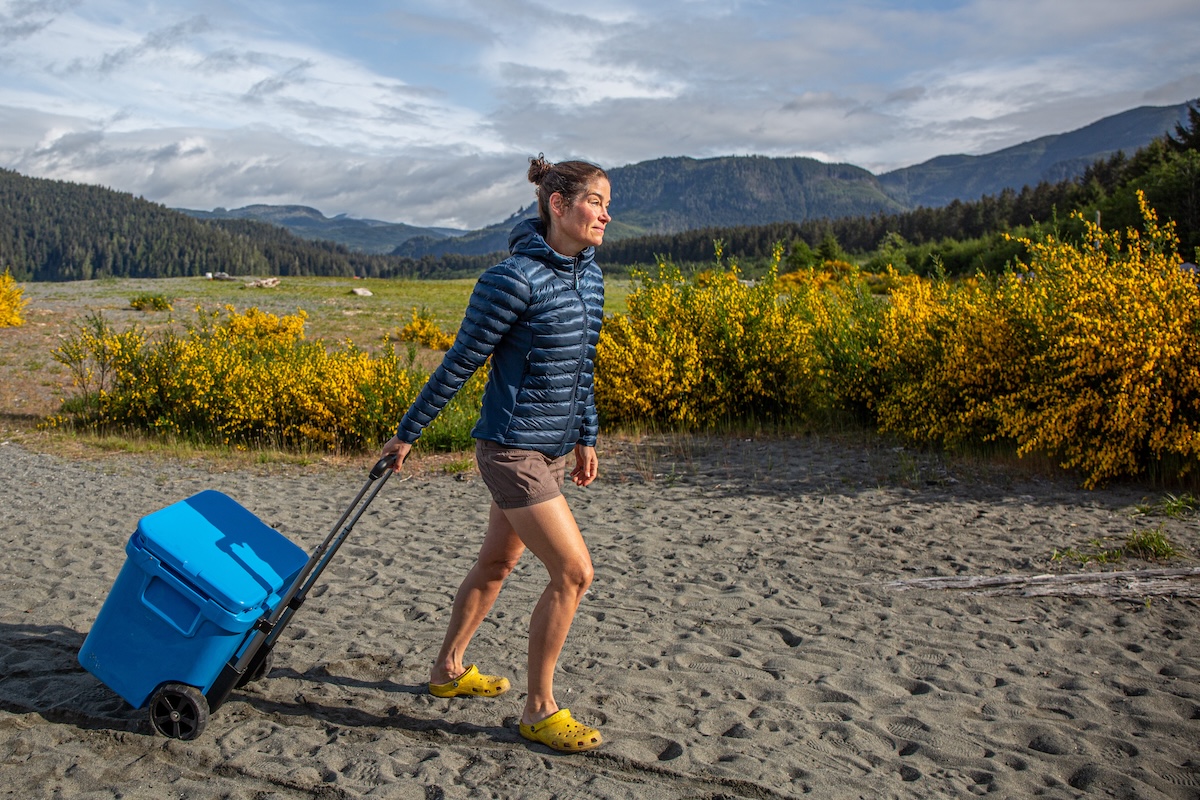
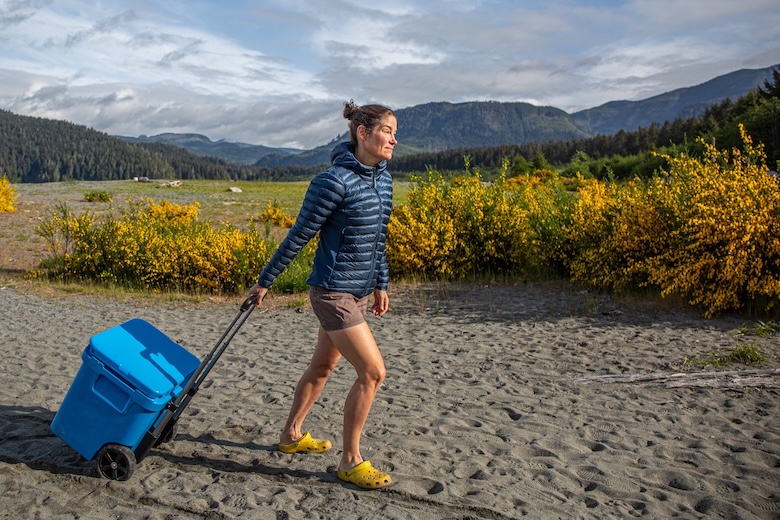
If your cooler must-haves include easy portability and large capacity, a wheeled cooler is the way to go. Like standard hard-sided models, many of today’s top wheeled coolers can keep ice frozen for several days with the added ability to cover longer distances—whether you’re trucking them to your campsite, along the river, or to a cabin retreat. Our current favorite wheeled cooler is the Yeti Roadie 48, because of how easy it is to maneuver, how simple it is to pack, and how easy it is to store all your snacks in the capacious interior. For more background information, see our comparison table and buying advice below the picks. For a broader perspective, we've also compiled lists of the best coolers, best soft-sided coolers, and best backpack coolers.
Editor's note: We updated this guide on September 30, 2025, to remove the discontinued Xspec 45-Quart Wheeled Cooler, add testing notes and photos from the past season, and ensure that all other colors, prices, and specifications are up to date.
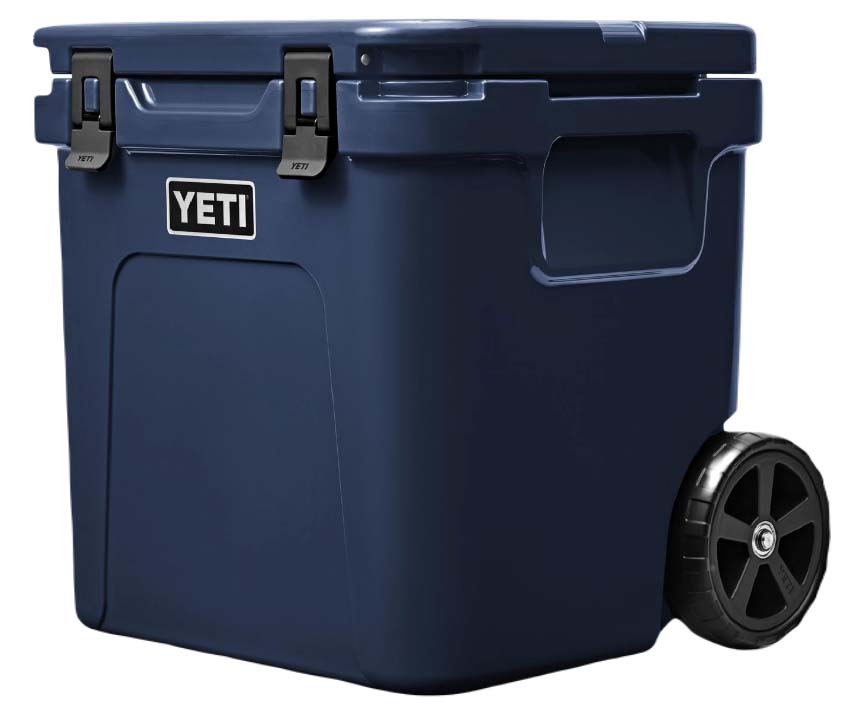 Construction: Rotomolded
Construction: Rotomolded
Capacity: 45.3 qts. (76 cans)
Weight: 28 lb. 4.8 oz.
Other sizes: 32, 60 qts.
What we like: Class-leading build quality and insulating performance with a smaller form factor than many competitors.
What we don’t: You pay a steep premium for the Yeti name, not bear proof like the Tundra line.
Yeti’s signature Tundra line—including the towable Tundra Haul—put the brand on the map. Still, the Roadie offers similar performance in a more space-conscious package that retains the shape of the original (non-wheeled) model. In addition to taking up less space than most similarly-sized competitors, the tall build allows for efficient packing. You can fit a lot of food and drinks below the dry goods basket—wine bottles can stand upright—and it makes the cooler easier to tow and move around than many alternatives, including the Tundra Haul. We also love the latches, which are easy to operate even with one hand, and the handle is sturdy and thoughtfully built with enough length to clear your heels when walking. Added up, it’s an exceptional wheeled cooler that will stand up to years of abuse.
The rest of the Roadie’s design reflects Yeti’s typical attention to detail. Ice retention is top-notch thanks to the thick walls, proven PermaFrost insulation, and quality gasket; the exterior is sleek and streamlined; and the wheels roll smoothly over most surfaces. The RovR RollR cooler fares a bit better in soft ground and on bumpy trails in our experience, but the Roadie is capable on most terrain. We'd love a future update that comes with the option of bear-proofing the cooler, but as long as you're careful with storage in bear country, you should be fine. Finally, it’s worth noting that you can go bigger for the price with the RollR or Yeti’s own Tundra Haul (by 12 and 5 qts. respectively), but the Roadie’s smaller form and best-in-class latches won us over.
See the Yeti Roadie 48

 Construction: Rotomolded
Construction: Rotomolded
Capacity: 60 qts. (60 cans)
Weight: 40 lb.
Other sizes: 45, 80 qts.
What we like: Capable wheels and an impressive selection of accessories and add-ons.
What we don’t: Less thermally efficient than Yeti designs, stiff latches, and very heavy.
RovR’s aptly named RollR is their flagship design and gives the Roadie above a run for its money in several key areas. First are the wheels: With aggressive tread reminiscent of all-terrain tires, they cruise smoothly over everything from maintained trails to tricky surfaces like sand and rocky shorelines. Second is RovR’s impressive selection of fun add-ons, from kitchen basics like a prep board and cup holders to canvas bins that fit perfectly inside the cooler, balloon tires for shuttling longer distances through sand, and even an attachment kit for towing behind your bike. Importantly, most other details are equally well sorted, including a practical interior—half is a dry goods bin, and the slanted base allows for melted ice to sit underneath to keep food cold—but not wet. The long handle is easy to grab from either side, and we like the quality components that have held up well over the long term.
While the RollR’s wheels are the most capable on this list, we came away less impressed by the latch design. Despite featuring thumb loops for leverage when opening the lid, the latches require considerable force—and sometimes two hands—to operate. We also found the RollR to be a small step down from Yeti’s Roadie above and Tundra Haul below in insulating performance, and it’s the heaviest of the bunch at 40 pounds empty. But overall, the RovR is an excellent all-around performer with unmatched portability and customization options, earning it very high marks on our list for the past several seasons.
See the RovR Products RollR 60
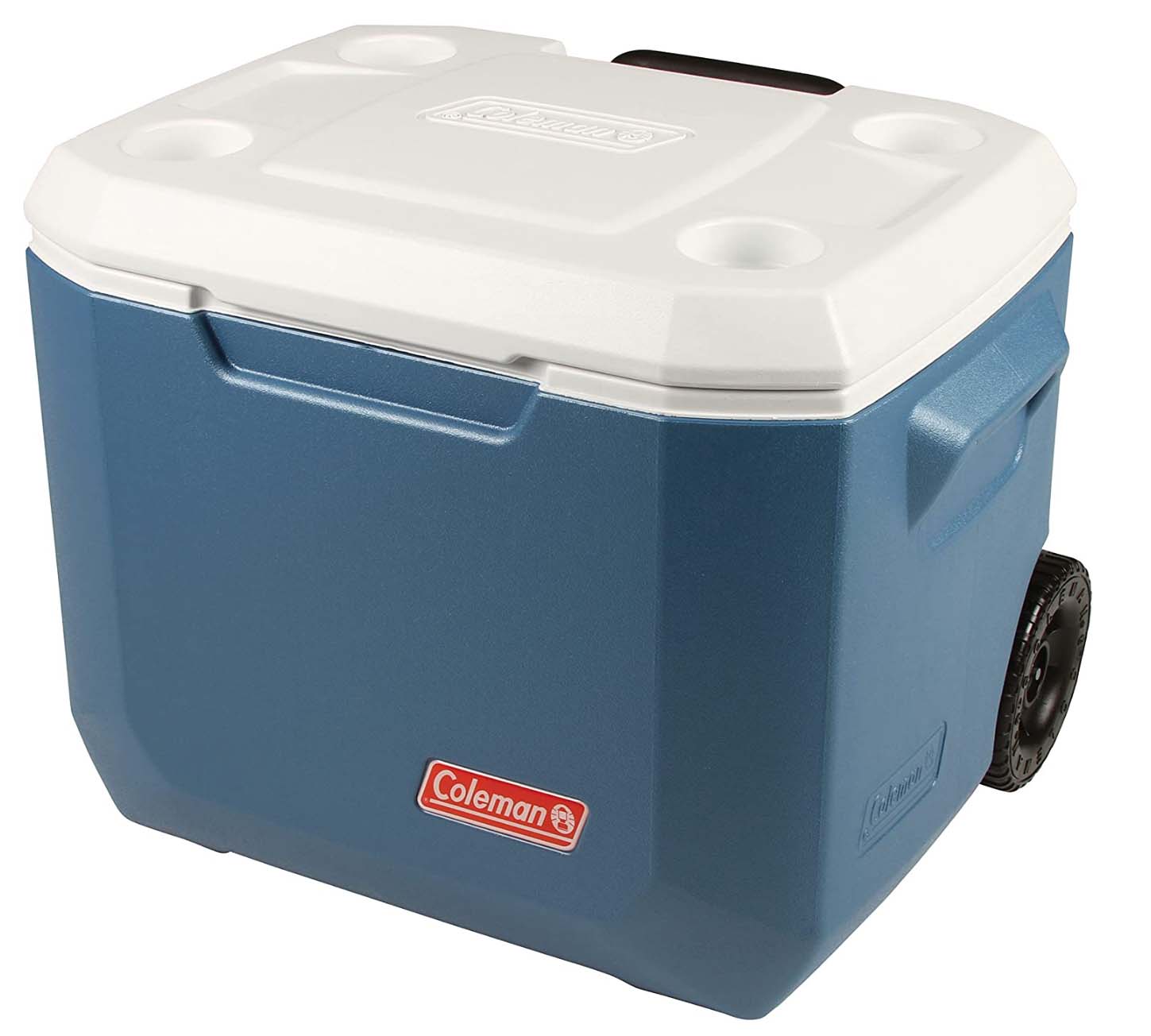 Construction: Plastic
Construction: Plastic
Capacity: 50 qts. (84 cans)
Weight: 12 lb. 11.2 oz.
Other sizes: None
What we like: Cheap, lightweight, and will get the job done for most casual campers.
What we don’t: Limited ice retention and long-term durability.
Coleman is a consistent cost leader, so it's not a big upset that their 50-quart Xtreme 5-Day scores our vote as the best budget design. Right away, we’ll note that this basic cooler is a far cry from modern options from brands like Yeti and RovR, but overall functionality is decent for the price. The simple plastic wheels and telescoping tow handle make transporting the cooler over smooth surfaces relatively easy, the hard-sided build provides modest insulation for day or short overnight getaways, and the integrated cup holders built into the lid are convenient for storing drinks. Taken together, the Coleman should meet the needs of many recreational campers, beach-goers, and tailgaters without breaking the bank.
That said, as with any budget product, the Xtreme wheeled cooler makes sacrifices to cut costs. First, it’s far less durable than premium roto- and injection-molded models. When testing them back-to-back, the cheap and lightweight materials were very noticeable. We also had trouble keeping the lid open while loading and unloading the cooler, which made the process painstaking, and the plastic wheels struggled even on marginally bumpy paths. Finally, as we touched on above, we’ve found Coleman’s five-day ice retention claim to be overly optimistic, because in practice, it’s been much shorter for us. But again, it’s hard to knock the price of the Xtreme wheeled cooler, which is enough of a selling point for occasional campers and done-in-a-day activities. For another great value from Coleman, check out their 316 Series wheeled coolers, which come in 62, 65, and 100-quart capacities.
See the Coleman 50-Quart Xtreme 5-Day
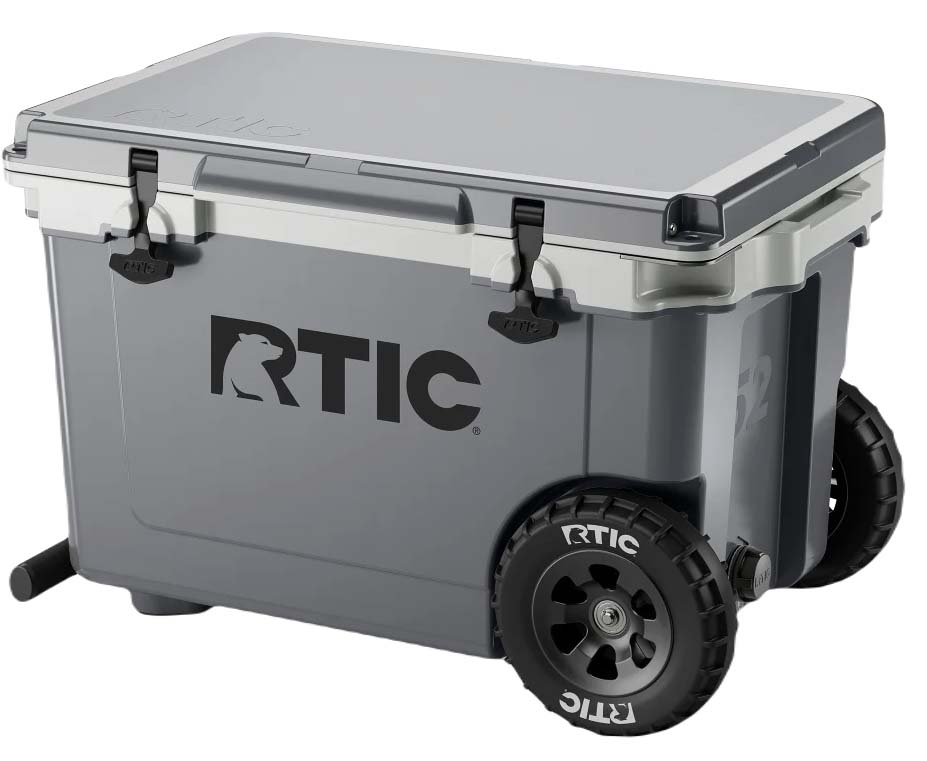 Construction: Injection-molded
Construction: Injection-molded
Capacity: 52 qts. (78 cans)
Weight: 30 lb.
Other sizes: 22, 72 qts.
What we like: Versatile size, practical feature set, and good ice retention at a competitive price and weight.
What we don’t: Only sold online; injection-molded construction is less premium than rotomolded designs.
RTIC consistently strikes a great middle ground between price and performance, and their 52 QT Ultra-Light Wheeled Cooler is no exception. For considerably less than the Roadie and RollR above, the RTIC checks most of the boxes for a well-built and well-rounded wheeled cooler. Starting with features, the Ultra-Light has heavy-duty wheels that do a good job absorbing impacts, a handy silicone cargo net underneath the lid for stashing foods like fruit or deli meat, and a sturdy aluminum handle with grips for easy towing. Here's a nice touch: It falls gently back in place if you suddenly let go. You also get quality T-handle latches to seal the lid shut, tie-down slots and holes for locks, and even a built-in bottle opener at one corner. Taken together, the RTIC is a standout value.
As its name suggests, the Ultra-Light is around 5 to 10 pounds lighter than most competitors, which can make a significant difference when loading and unloading the cooler from your vehicle. This is achieved through injection molding. Unlike rotomolded competitors that are made from a continuous piece of plastic, the Ultra-Light uses separate sections that are pieced together, requiring less material. In theory, the trade-off is a step down in durability compared to rotomolded alternatives like the Roadie and RollR above, although we’ve been impressed by how well our RTIC coolers have held up over the years. The Ultra-Light is competitive in ice retention, too—with the recommended 2:1 ice-to-food ratio, it will handily keep food and drinks cold on weekend trips (or longer, depending on conditions). RTIC recently added a 22-quart size to this line, with a similar upright design to the Yeti Roadie above. We tested the 22 on a recent week-long road trip and came away impressed with the portability, though we maxed out the capacity for two people and had to limit our cold goods, and feel the 52 is a more versatile option if you have the space.
See the RTIC 52 QT Ultra-Light Wheeled
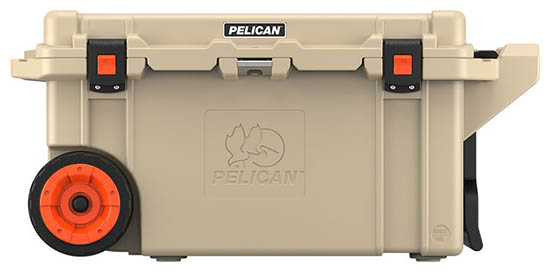 Construction: Injection-molded
Construction: Injection-molded
Capacity: 80 qts.
Weight: 52 lb.
Other sizes: 45, 65 qts.
What we like: A massive, bombproof wheeled cooler for transporting game or fish.
What we don’t: Very heavy, bulky, and expensive; the short handle makes it awkward to pull.
For uses like hunting, fishing, or other activities that warrant a high-capacity cooler, the Pelican 80QT Elite is a true standout. Right off the bat, let's address the astronomical price: This cooler is the most expensive unit here by a sizable margin and has limited appeal for the average outdoor-goer. But for safely transporting game or fish, there’s a whole lot to like. The Pelican boasts heavy-duty wheels and wide, glove-friendly latches for easy towing; ice retention is excellent thanks to the freezer-grade seal and quality foam insulation; and you even get an integrated fish scale and garden hose-compatible drain plug to make cleaning a breeze. All told, it's a very rugged and thoughtfully built design for recreationalists who intend to utilize the massive capacity and specialized feature set.
Pelican designs many of its products for military and law enforcement use, and that tactical styling is apparent in its cooler line. In other words, if you’re looking for a sleek and streamlined unit, this isn’t it. The handles are bulky and rigid—and unfortunately, the pull handle is short enough to make walking uncomfortable—the color options are relatively subdued, and the cooler itself is undeniably hefty at nearly 50 pounds before food, drinks, and ice. But again, most people who buy this cooler aren’t overly concerned with looks and simply want a large, beefy, and functional option for storing game or fish. If that’s your end use, the 80QT Elite should be on your short list, and this cooler is backed by a lifetime warranty. If you like the design but don’t need the huge interior, the 45-quart and 65-quart Wheeled Elites offer similar appeal in a more manageable—albeit still very pricey—package.
See the Pelican 80QT Elite
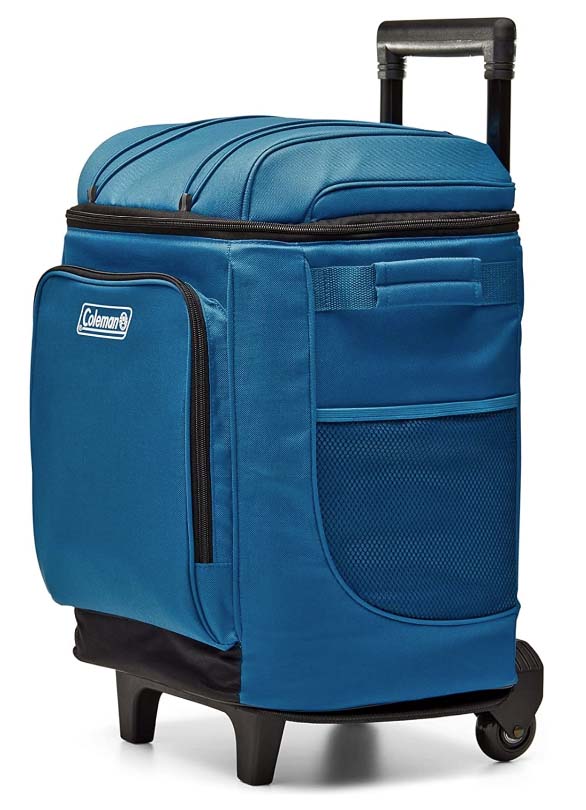 Construction: Soft-sided
Construction: Soft-sided
Capacity: 42 cans
Weight: 7 lb. 3.2 oz.
Other sizes: None
What we like: The cheapest design on our list and also one of the lightest.
What we don’t: Unimpressive ice retention and durability; tiny wheels.
The vast majority of wheeled coolers available are hard-sided, which is great for maximizing insulation performance but can be cumbersome to load and unload from your vehicle. Enter Coleman’s Chiller 42-Can Soft-Sided Cooler, which weighs just over 7 pounds and is far more manageable to move around, even when full. Another benefit of the soft-sided build is exterior storage. The Chiller features a mesh pocket at each side for stashing a water bottle or sunscreen, a large zippered pouch at the front for low-profile items like a wallet or map, and a bungee cord system on top of the lid for securing a light layer or towel. Inside, there’s an additional mesh pocket under the lid that’s sized for an ice pack, along with the hard-plastic liner that helps the cooler maintain its shape and slides out easily for cleaning. All told, it’s a pretty practical design that belies the price tag.
Still, calling the Coleman Chiller a wheeled cooler feels like a bit of a stretch. The cooler technically has wheels, but they’re small and under-built for anything other than paved trails and smooth surfaces, and the rolling suitcase-like shape can feel tippy on uneven terrain. Some users also note that the telescoping handle is prone to collapsing (we haven't experienced this, although it doesn't truly "lock" into place at the top), and the TempLock insulation is far less capable at keeping ice frozen than the thick foam you get with hard-sided alternatives (ice retention is listed at just 12 hours). Finally, the Chiller lacks a plug for draining melted ice, which can lead to a soupy interior. In the end, the lack of performance limits the Coleman's appeal, but it has its place for day trippers looking for a less expensive and lightweight option that they can tow—rather than carry—short distances.
See the Coleman Chiller 42-Can Cooler
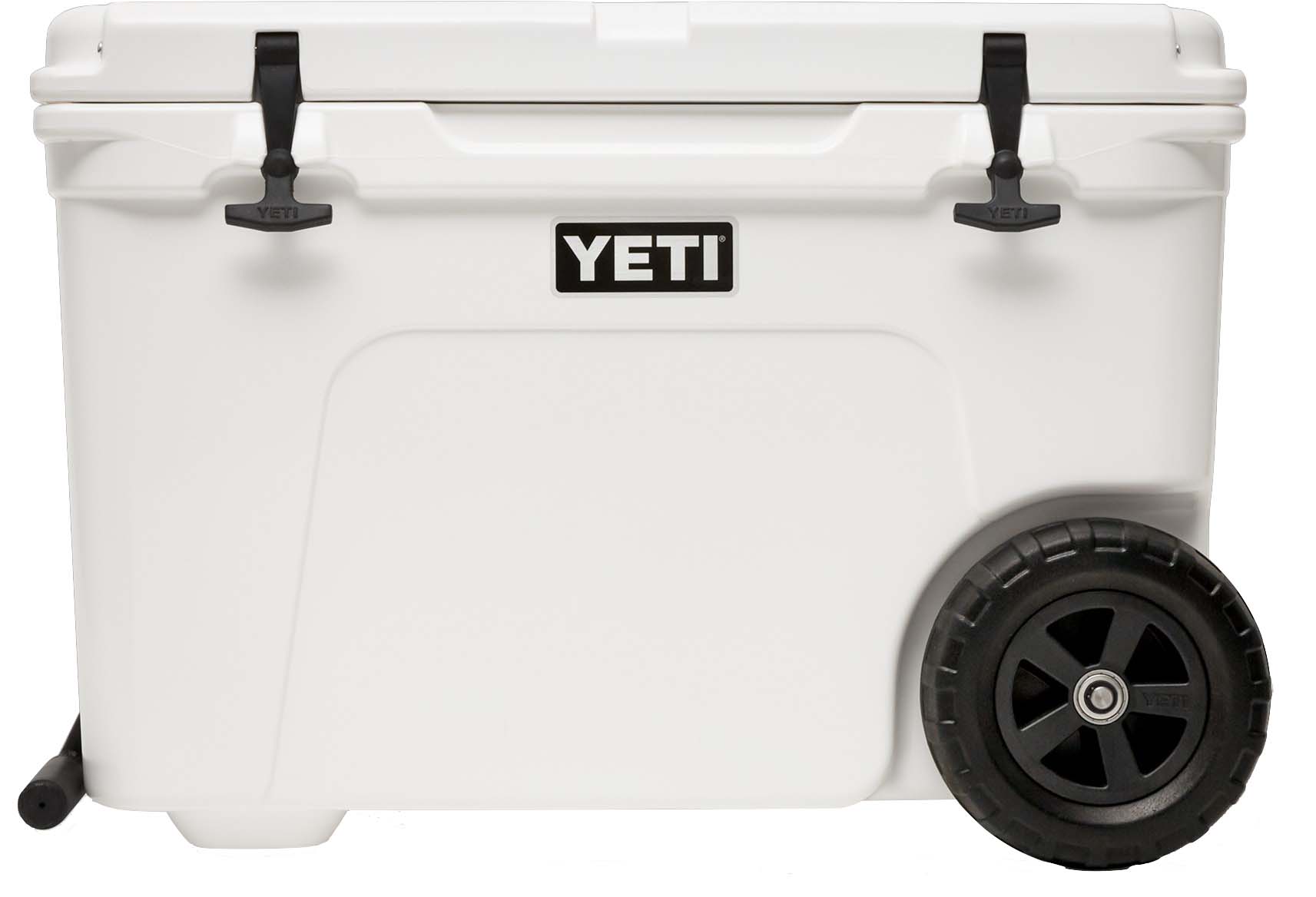 Construction: Rotomolded
Construction: Rotomolded
Capacity: 50.3 qts. (82 cans)
Weight: 37 lb. 8 oz.
Other sizes: None
What we like: Typical Yeti quality and attention to detail.
What we don’t: Takes up more space than the Roadie above, with only a marginal boost in capacity.
No one does high-end coolers quite like Yeti, and their Tundra Haul joins the Roadie as another exceptionally built design with class-leading cooling capabilities. Like the non-wheeled Tundra coolers, the towable Haul scores high marks in ice retention with a thick rotomolded build that’s more durable and less prone to cracking than injection-molded options like the RTIC above. The rest of the design exudes the same level of quality: The wheels are well executed with good tread and enough surface area to tow over rough terrain, the rubber T-handle latches provide a confidence-inspiring seal (although they’re harder to operate than the Roadie’s QuickLatch system), and everything from the welded aluminum handle to the thick rubber feet has a sturdy look and feel. Unlike the Roadie, the Tundra is also certified as bear-resistant when used with Yeti’s Bear Proof Locks ($30 per set), which is a worthwhile consideration for those who frequent the backcountry.
Why does the Yeti Tundra Haul come in below the brand's Roadie? The biggest reason is space savings: The Roadie 48’s bottom is around 125 square inches smaller than the Tundra Haul’s, with only a marginal drop in capacity (the Tundra Haul can fit 8 more cans, according to Yeti). In fact, even the larger Roadie 60 (58.2 qts.) has a smaller footprint than the 50.3-quart Tundra. Both Roadies are also lighter, can fit wine bottles upright, and have more intuitive latches that are easier to manipulate with one hand. Some will prefer the Tundra's rigid handle over the Roadie's telescoping design—with more moving parts, telescoping handles are more prone to failing and breaking over time—although it's largely personal preference. In the end, you really can’t go wrong with either collection, but the Roadie’s similar appeal in a lighter and more space-conscious package gives it the overall edge for us.
See the Yeti Tundra Haul
 Construction: Injection-molded
Construction: Injection-molded
Capacity: 70 qts. (112 cans)
Weight: 34 lb. 11 oz.
Other sizes: None
What we like: Massive interior; creative exterior storage and feature set.
What we don’t: Lots of moving parts, no latch for the lid, and middling ice retention.
In stark contrast to the sleek designs from Yeti and RovR is Igloo’s utilitarian Trailmate Journey. You get a massive interior that Igloo states can fit over 100 12-ounce cans, a dry goods basket for separating fruit and other fragile food items, and a tray underneath the lid that can be removed and placed on the telescoping handle for storage and food prep. Outside, the Trailmate takes a no-holds-barred approach: The handle tucks away neatly when not in use and expands with the push of a button, there’s both a pocket and lockable compartment for divvying up snacks and other extras, the oversized (10-in.) wheels have deep tread to plow through soft ground, and Igloo even included pole slots to hold beach umbrellas or fishing rods. And unlike other designs here, the Trailmate is positioned off the ground via skid rails to maximize cooling performance.
No cooler is perfect, however, and we do have some complaints about the Igloo Trailmate Journey. First is ice retention, which falls notably short of premium rotomolded competitors. The lack of a lid latch doesn’t help—there’s no way to secure the lid shut to seal in cold, which feels like an oversight. More moving parts also mean more potential for durability issues, and some users have reported premature problems with the telescoping handle and the thin cable that prevents the lid from overextending when open. Finally, not everyone will like the tactical looks and styling. But the Igloo is a solid value and one of the most well-equipped options on the market.
See the Igloo Trailmate Journey
The Arctic Zone Titan 60 Cooler is a wheeled cooler that's notable because it can be detached from its wheels, but otherwise, we didn't find that it outperformed our soft-sided pick.
We looked at the Coleman EcoCool Latitude 60 as a budget option, but it's only 10 quarts larger than our top pick, the Coleman 50-Quart Xtreme 5-Day, and $35 more expensive.
| Wheeled Cooler | Price | Construction | Capacity | Weight | Other Sizes | Ice Retention* |
|---|---|---|---|---|---|---|
| Yeti Roadie 48 | $425 | Rotomolded | 45.3 qts. (76 cans) | 28 lb. 4.8 oz. | 32, 60 qts. | Unavail. |
| RovR Products RollR 60 | $399 | Rotomolded | 60 qts. (60 cans) | 40 lb. | 45, 80 qts. | 10 days |
| Coleman 50-Quart Xtreme | $65 | Blown plastic | 50 qts. (84 cans) | 12 lb. 11.2 oz. | None | 5 days |
| RTIC 52 QT Ultra-Light | $279 | Injection-molded | 52 qts. (78 cans) | 30 lb. | 22, 72 qts. | 8 days |
| Pelican 80QT Elite | $589 | Injection-molded | 80 qts. | 49.5 lb. | 45, 65 qts. | 10 days |
| Coleman Chiller 42-Can | $65 | Soft-sided | 42 cans | 7 lb. 3.2 oz. | None | 12 hours |
| Yeti Tundra Haul | $450 | Rotomolded | 50.3 qts. (82 cans) | 37 lb. 8 oz. | None | Unavail. |
| Igloo Trailmate Journey | $250 | Injection-molded | 70 qts. (112 cans) | 34 lb. 11 oz. | None | 4 days |
*Editor's note: The ice retention number represents claimed time from the manufacturer—in real-world use, we've found these times to be lower. More in our "Ice Retention and Cooling Capabilities" section below.
Here at Switchback Travel, we’re big proponents of enjoying good food and cold beverages while camping—it can make a big difference when you’re outside for days at a time. Managing editor Sarah Nelson kicked off this list in early 2024 to supplement our three other cooler guides: hard-sided coolers, soft coolers, and backpack coolers. Previously living on the road full-time in her converted van, Sarah is acutely aware of the space and energy constraints associated with traveling and was very selective in putting together the lineup above. Contributing editor Maggie Slepian now manages the guide, bringing her background in low-maintenance truck camping to the team. Maggie has never owned a van or RV and relies entirely on coolers to keep food and drinks cold on extended road trips and basecamping expeditions.
In putting together the list above, ice retention was at the top of our priority list. However, since many of the highest performers are expensive, we made sure to balance cooling capabilities with price—there’s a reason RTIC’s $279 52 QT Ultra-Light ranks high in our lineup. Another important factor for us was portability, including the quality and handling of the wheels and handles, along with overall weight, because it can be difficult to lift some of these behemoths out of a trunk or truck bed. Finally, the smaller details can make or break a cooler, so we paid close attention to features like latches and closure systems, drains, and any other accessories (e.g., bottle openers) included with purchase.
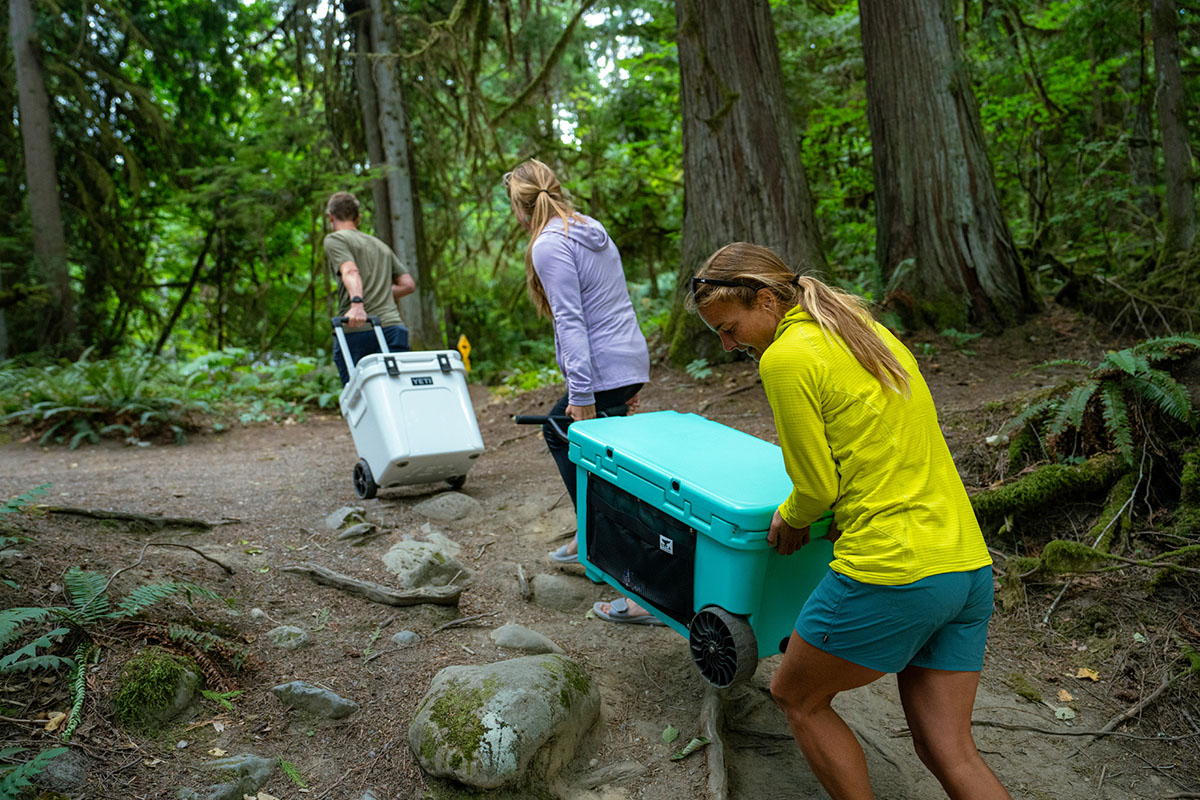
Most high-end wheeled coolers are made via one of two methods: rotational molding (rotomolding) or injection molding. At the cheaper end of the spectrum are simple plastic and soft-sided offerings that weigh less but fall short in durability and cooling capabilities. Below, we break down the pros and cons of each construction type.
Rotomolded Coolers
Rotomolding was popularized by Yeti (although they technically weren’t the first to make a cooler in this way) and currently dominates the high end of the market. These types of coolers are made by filling a mold with material that's been powdered, and as the mold rotates, the powder gets distributed evenly around the mold, heats up, and solidifies into a continuous, seamless part. The advantages are fewer stress points (these coolers are less likely to crack under pressure) and a consistently thick outer shell, which translates to exceptional durability. Primary disadvantages are cost and weight. A final point to note is that rotomolded designs don’t offer any inherent advantages in ice retention that we've found in our testing. Insulation thickness is the major player in keeping things cooler, longer.
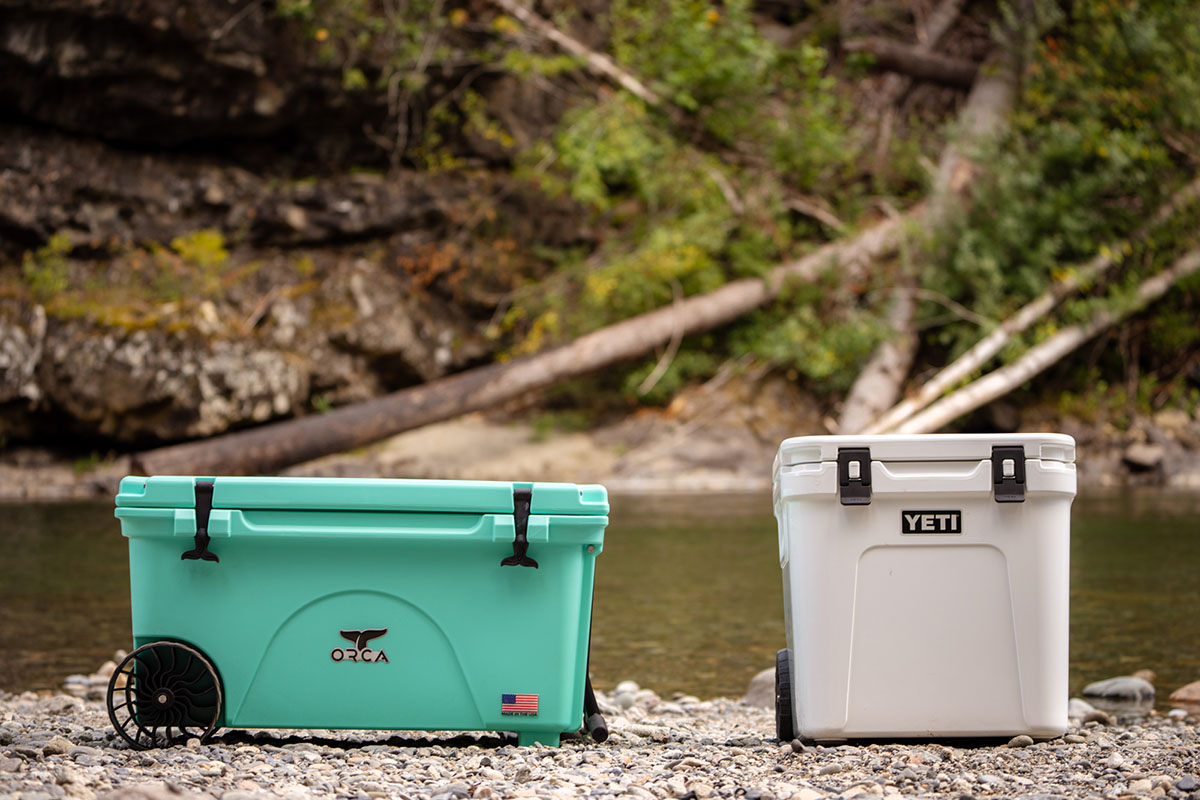
Injection-molded Coolers
Injection-molded coolers are made by inserting hot plastic into defined molds and assembling the separate sections together once they’re cooled. The process is simpler and cheaper than rotomolding, uses less material, and allows for greater precision because of the molded shapes. However, the fact that injection-molded coolers are made with multiple pieces—unlike the single, uninterrupted form with rotomolding—can lead to a drop in durability and added susceptibility to cracking. That being said, a quality build like RTIC’s 52 QT Ultra-Light stacks up favorably to top rotomolded competitors in overall toughness. Many injection-molded designs also allow for various mounting locations for accessories like tables, cup holders, and cutting boards, which is something you don’t typically get with rotomolding (although there are exceptions).
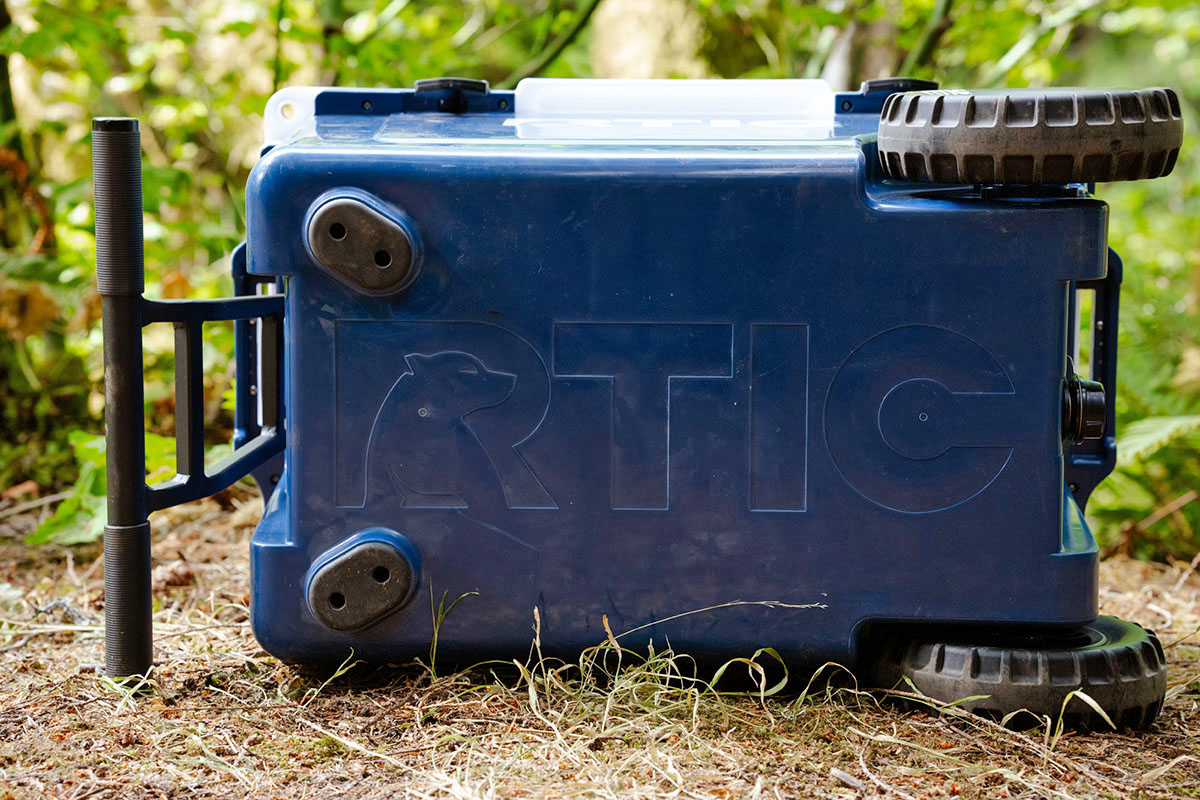
Blow-Molded Coolers
Blow-molding is the least expensive way to form plastic parts, and coolers like Coleman’s 50-Quart Xtreme are made this way. While less durable than rotomolded and injection-molded alternatives, designs like the Xtreme and will get the job done for day trips to the park or beach, tailgates, or other short outings. They also weigh significantly less, checking in at around half the weight of other hard-sided options. All in all, if you aren’t ready to spend hundreds of dollars on a cooler and only plan to use it a couple of times a season, a plastic model could be the way to go.
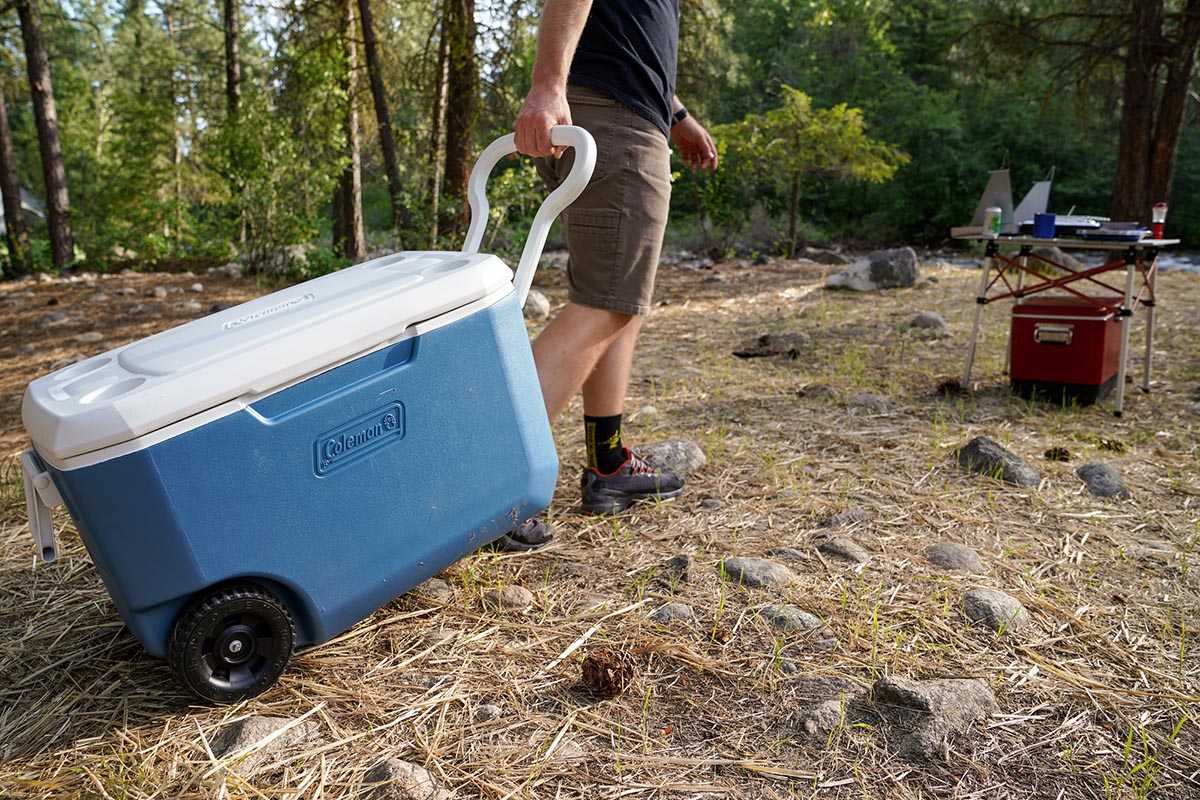
Soft-sided Coolers
Soft-sided wheeled coolers are the lightest option available, but don’t stand out in many other areas. For starters, ice retention is a step down from even basic plastic models—the Coleman Chiller, for example, is listed at twelve hours and 3 days respectively, which can’t hold a candle to the multi-day ice retention you get with most hard-sided competitors. They’re also inherently less durable and relatively limited in storage space. Some do collapse down for storage, including the Titan, which helps maximize space in your garage or trunk, and they’re much easier to hoist in and out of a vehicle. The Titan can also be detached from its rolling cart for carrying over the shoulder, which can be a nice option to have, depending on the terrain and your objectives. But overall, we feel there’s little reason to opt for a soft-sided wheeled cooler over a similarly cheap plastic design.
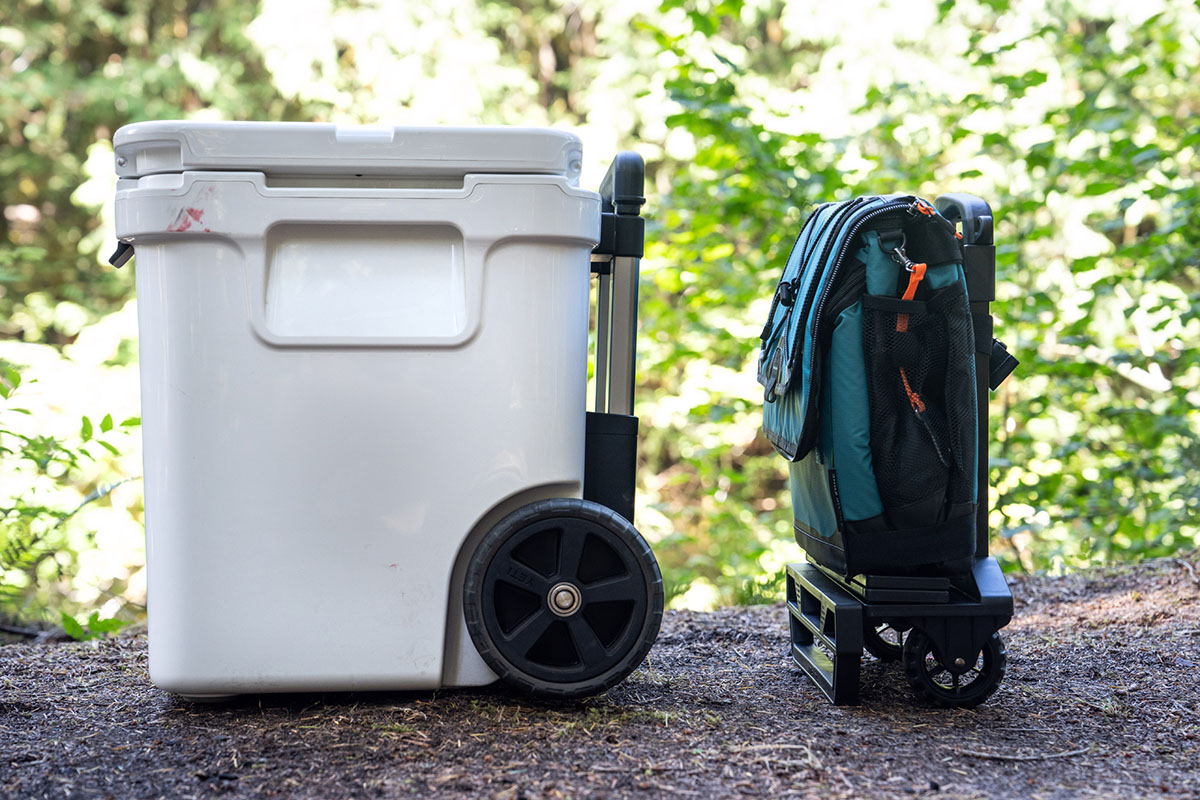
There are a few considerations to note regarding size. Most importantly, not all coolers measure interior capacity in the same way. Soft-sided designs like the Coleman Chiller use cans (without ice) as a unit of measure, while most hard-sided offerings use quarts. It’s also important to note that listed capacity and real-life storage space don’t always line up precisely—two coolers with the same listed capacity may differ considerably in how much interior space they offer due to the thickness of the walls. In our experience, tracking down a cooler’s interior dimensions (if available) can be a better way to get an accurate estimate of volume. Just remember that the inside might not be perfectly symmetrical, so usable volume is an approximation.
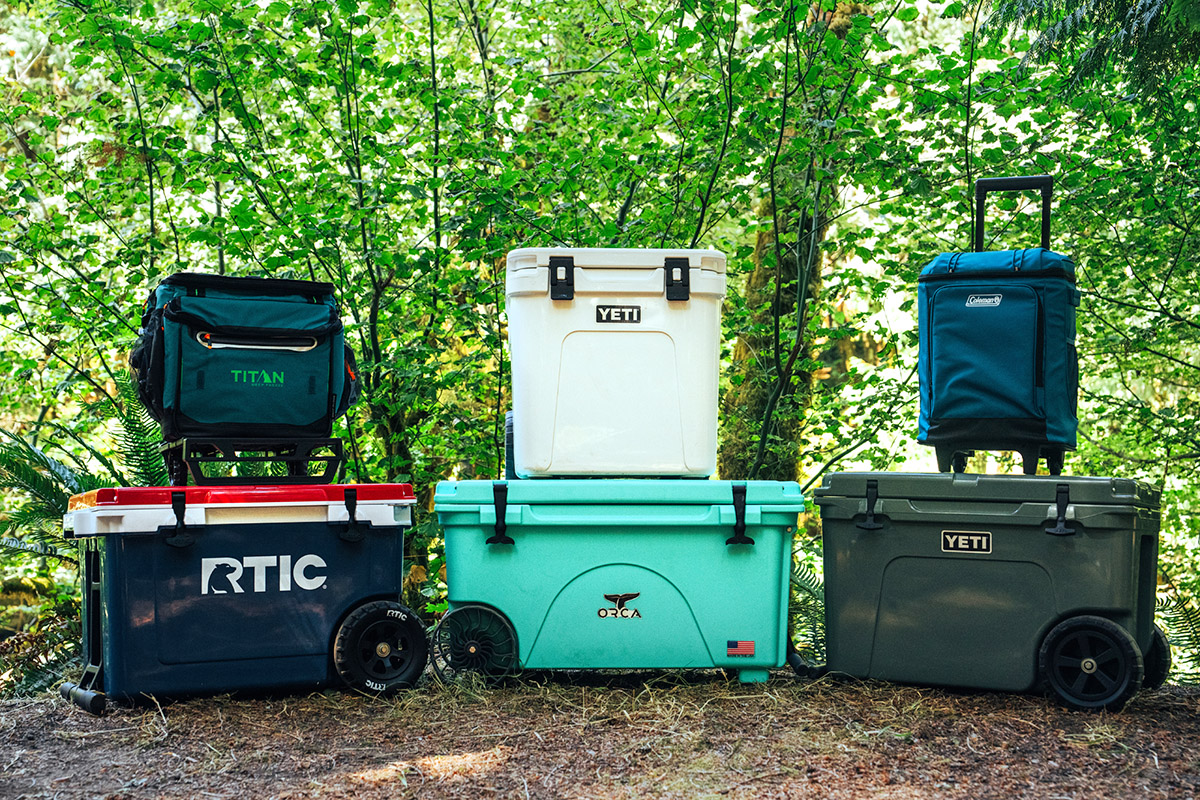
Small: Less than 45 Quarts
The smallest option on our list is the Coleman Chiller, which is a soft-sided design. This is no coincidence: Soft coolers are designed to be lightweight and easily portable, which translates to a lower weight. In general, they’re perfectly serviceable for day trips when you’ll only be packing a lunch and drinks for one or two people, but are undersized and underbuilt for multi-day outings that warrant multiple meals and cases of beverages.

Medium: 45 to 55 Quarts
Most hard-sided designs are much larger, ranging from 45.3 quarts for the Yeti Roadie 48 to 80 quarts for Pelican’s 80QT Elite (and you can certainly go bigger). At the lower end, 45- to 55-quart wheeled coolers are relatively manageable—although still hefty and bulky when packed full—and compact enough that they won’t take up your entire trunk or truck bed. In testing, we found this size to be sufficient for groups of two or three for a couple of days. If your party exceeds that, it’s worth bumping the capacity up to 55 quarts or higher for the same time frame. And if you plan to go on an extended outing or are traveling with a large group, you’ll want to check out the larger sizes below.
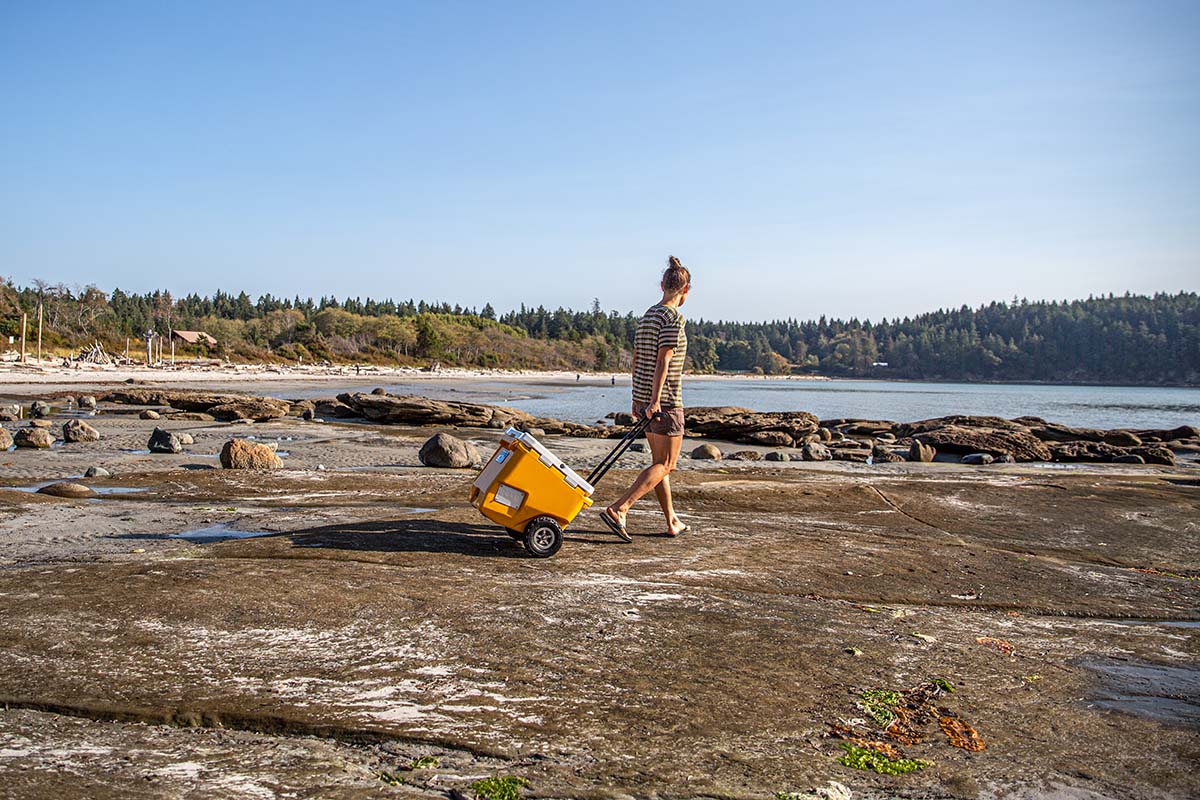
Large: 55 to 75 Quarts
If you’re headed out with two or more people over multiple days, it’s worth packing a large wheeled cooler. You may need a second person to help lift it in and out of the car, but the upside is enough space to utilize a proper 2:1 ice-to-food ratio to maximize performance (we cover this in more detail below). In the 55- to 75-quart range, we like RovR Products' RollR 60 best: It has a great mix of storage capacity, ice retention, and features that should meet the needs of most small groups on extended weekends or larger families on overnight trips. But at more than 26 inches long and almost 20 inches high, it does take up a sizable amount of space in a trunk or pickup bed.
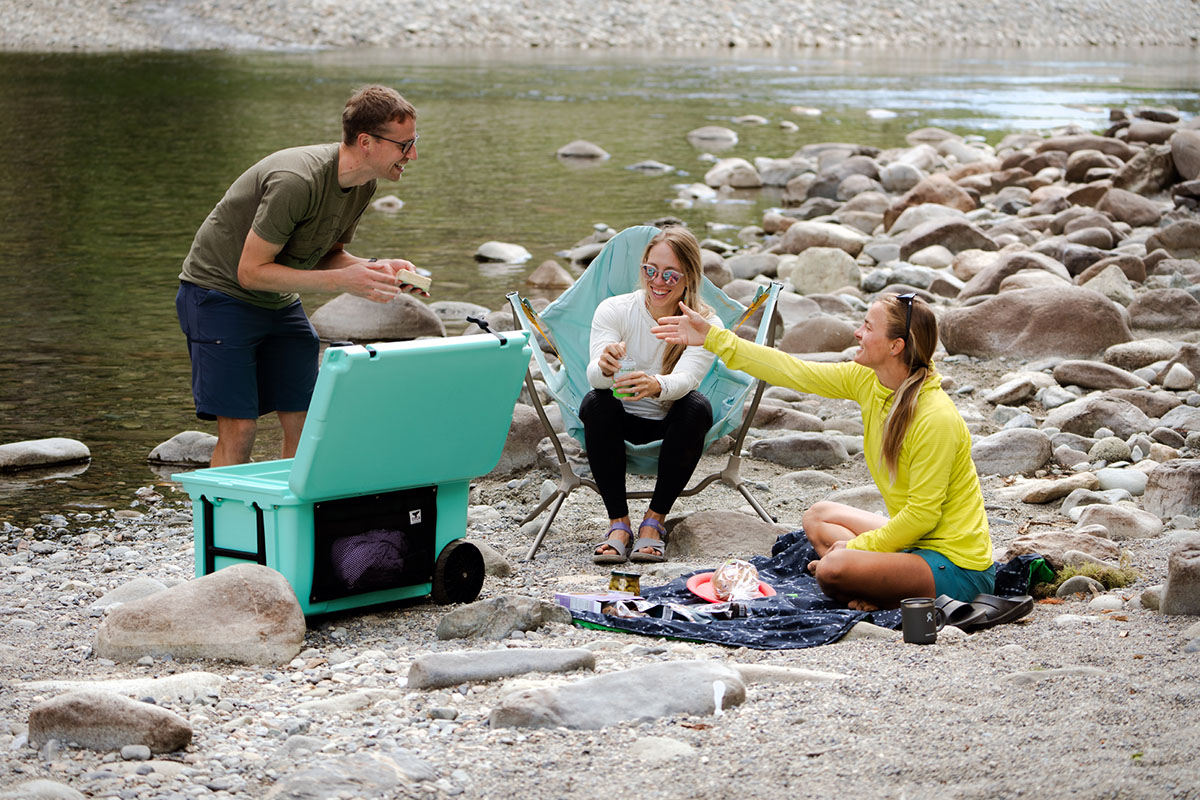
Extra Large: 75+ Quarts
Wheeled coolers in the 75-quart-and-larger range are typically reserved for the committed outdoorsperson. While undoubtedly expensive, extremely bulky, and heavy (the Pelican 80 QT Elite is over 50 lb. and a whopping $589), these extra-large models have their place for big groups and certain activities, such as fishing and hunting. That said, even wheeled designs of this capacity can be very unwieldy when full and nearly impossible to hoist in and out of a vehicle without help. In other words, if you opt for an extra-large wheeled cooler, you’d better have a good use for it.
Related to capacity, the shape of a wheeled cooler can make a difference in how easy it is to lift and move around, as well as how much floor space it takes up in a trunk or garage. This is one of the reasons we love Yeti’s Roadie 48: While only 5 quarts smaller than the Tundra Haul, the Roadie has a much smaller footprint, is easier to tow over obstacles, allows for efficient packing, and can accommodate wine bottles upright. Another benefit to the upright design is that you can stack a backpack or tote on top of the cooler during transport by threading the strap(s) over the handle. Some tall designs can feel a little tippy and less planted than their rectangular counterparts, but the difference is negligible in our experience (especially with high-end designs like the Roadie).
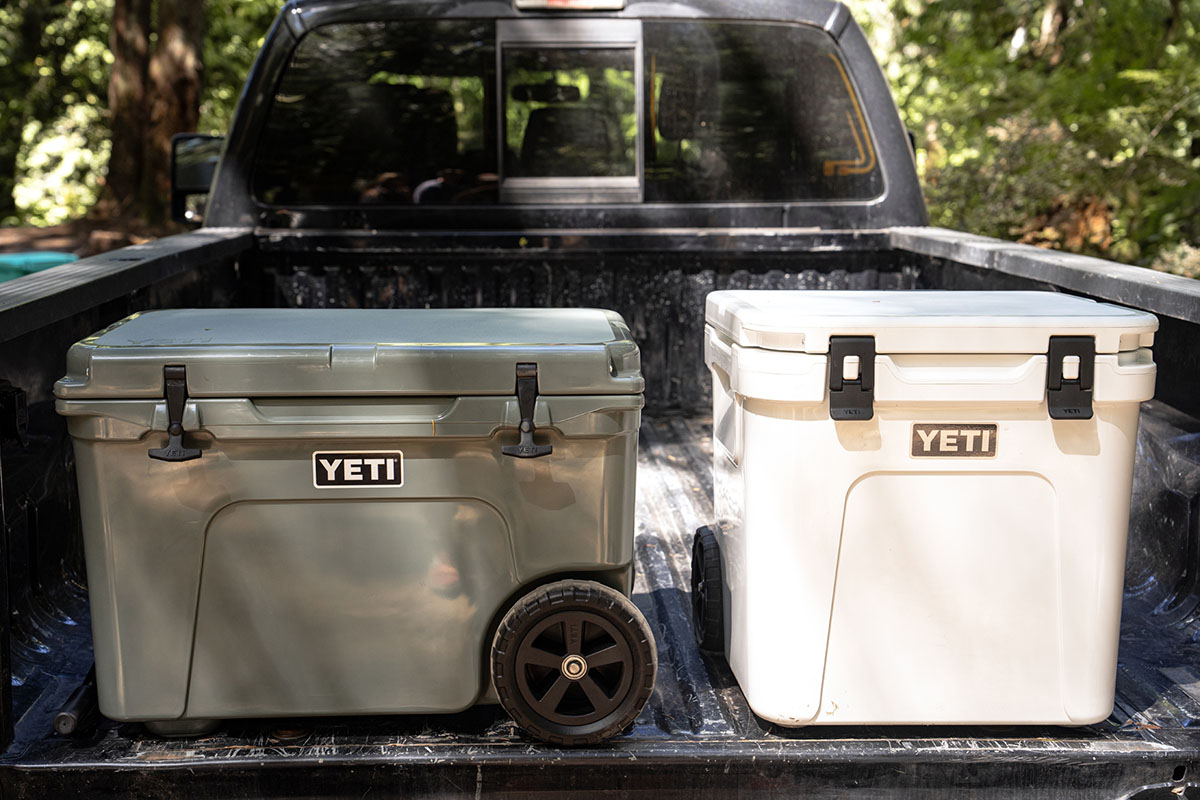
Ice retention—i.e., how long a cooler keeps ice frozen—can be tricky to pin down when researching coolers. Considerations like air temperature, direct sunlight, and the amount of ice you use can all make a difference in overall performance (most brands recommend a 2:1 ice-to-food ratio). It also matters how often you open the lid, thereby allowing cold air out and warm air in. For maximum performance, it’s best to pre-chill your cooler before loading it up. This involves filling the interior with ice for at least a few hours to bring its interior temperature down. When you’re ready to hit the road, swap in some fresh ice at that optimal 2:1 ratio along with your drinks and food. On the flip side, if you leave your cooler sitting out in the sun before loading it up, you can expect it to be preheated like an oven and not as effective.

Most cooler manufacturers provide a “claimed ice retention” spec in their product listings (Yeti is one major brand that does not). A quick look at the table above shows that the times range from 10 days at the high end for premium designs like the RovR Products RollR 60 and Pelican 80QT Elite to just 12 hours for Coleman’s Chiller 42-Can Cooler. That said, there isn’t an established, standardized test. In practice, most of the claimed ice retention times feel inflated to us, perhaps due to manufacturers' testing in extremely favorable conditions (storing the cooler inside with the lid closed in cool temperatures, for example). If we had to generalize, we would say that you should expect approximately half of the claimed ice retention time in real-world use, depending on your circumstances.
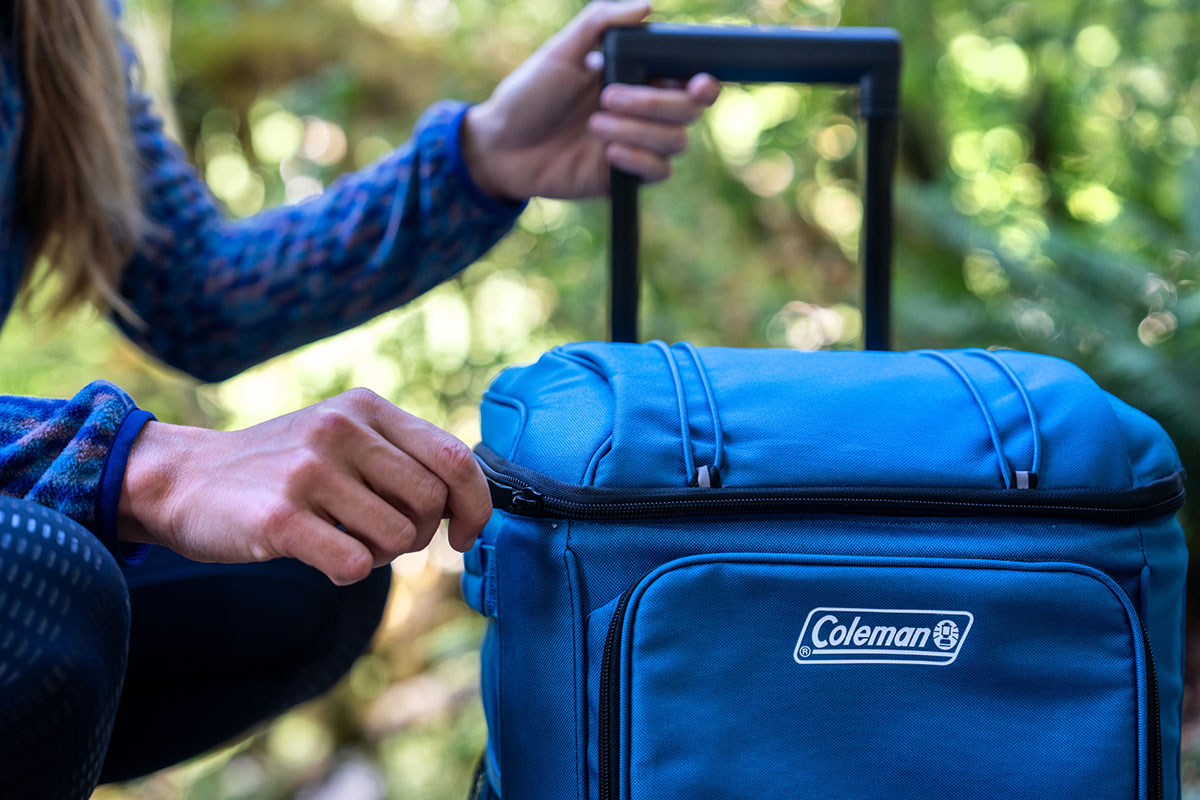
If you’re looking for maximum thermal efficiency, premium coolers from brands like Yeti and RovR are the leaders in keeping ice cold for long stretches. You pay for the privilege, but you can expect multiple days of cold temperatures and solid ice in your cooler with these high-end offerings, and that time goes down as you move toward less-insulated models. If you need ice for extended periods for activities like rafting or long camping trips, the cost is worth it. But for day trips or shorter overnights with access to new ice, an inexpensive cooler like the Coleman Xtreme is a fine option. And a final note: Latch design can have a big impact on thermal efficiency and often lines up with price, too.
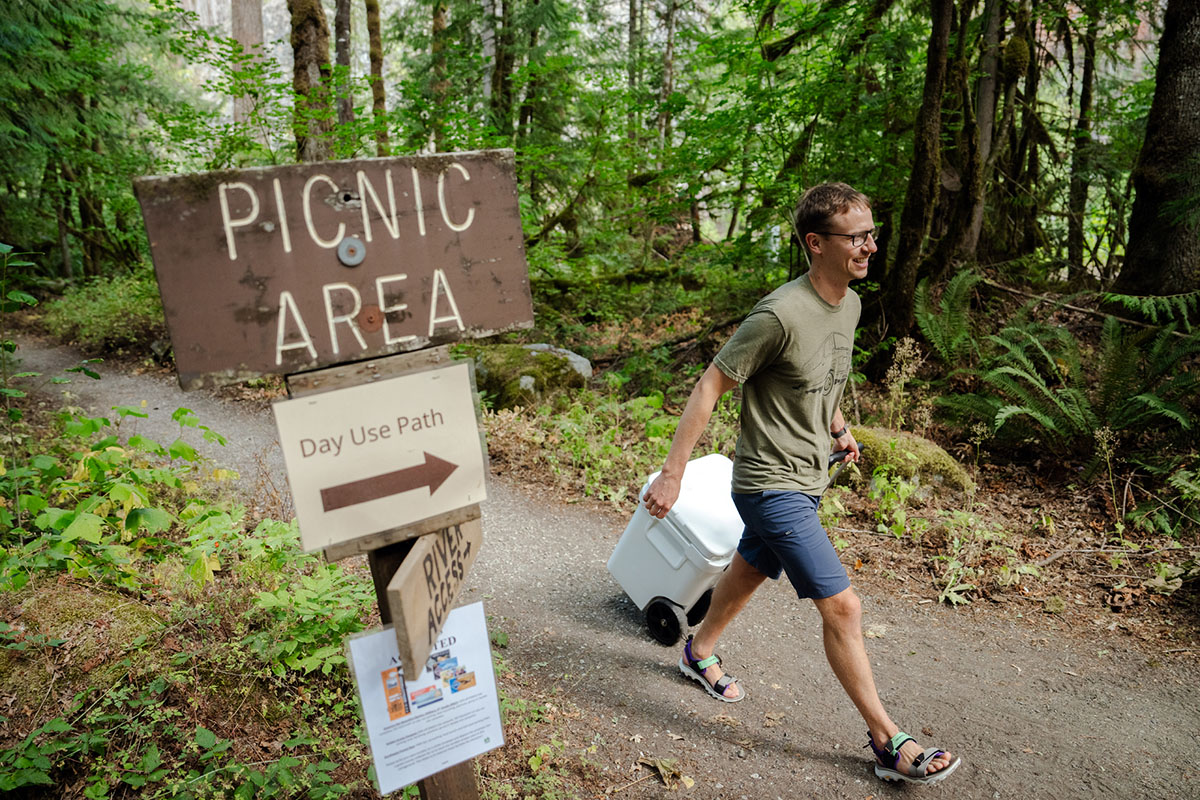
The wheel and handle design varies considerably between models and can have a sizable impact on a wheeled cooler’s portability. Starting with wheels, you can expect the best performance from high-end designs like the Yeti Roadie 48, RovR RollR 60, and Yeti Tundra Haul. The RollR's have aggressive tread that can handle tricky surfaces like sand and rocky shorelines. More wallet-friendly designs like the Coleman Chiller are underbuilt for anything other than paved paths and smooth surfaces.
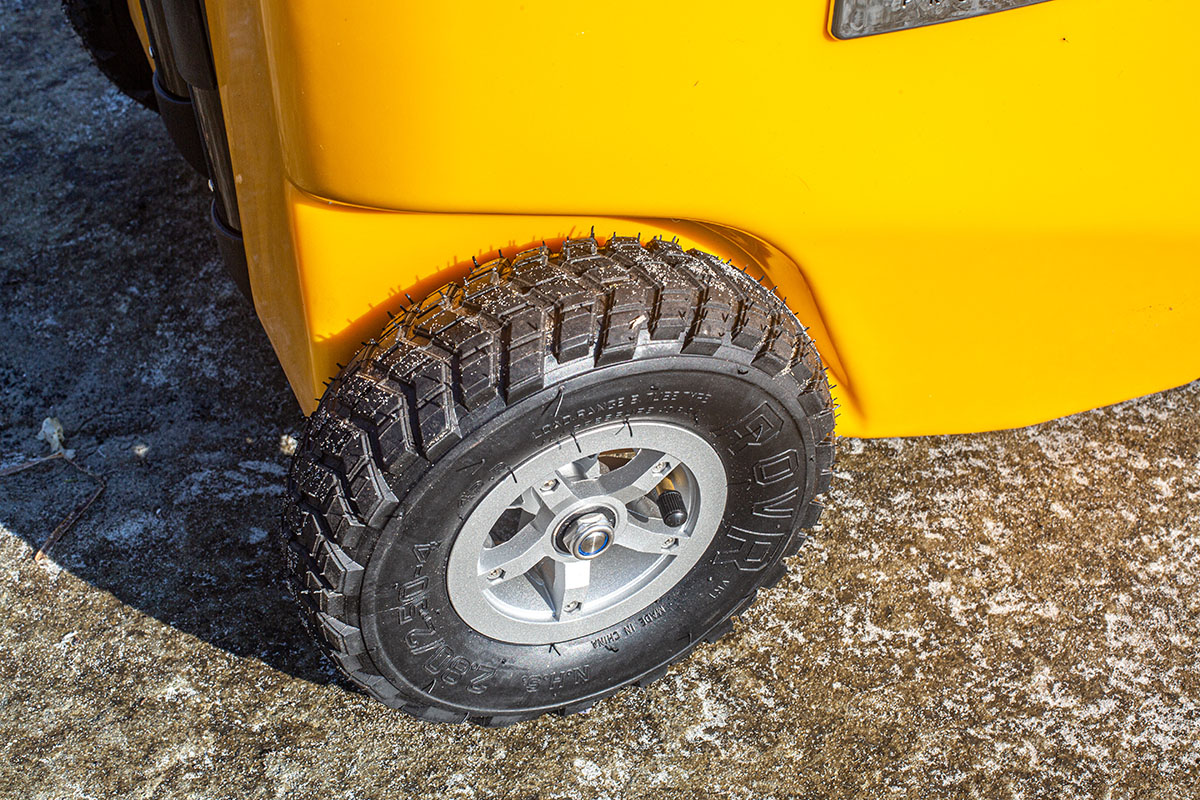
It's a similar story with handle design, which can be broken down into two main categories: telescoping or rigid. We’ve found that telescoping handles typically offer a little more control and versatility, but the parts can stick, fail, or break over time. Rigid handles are generally more confidence-inspiring but don’t extend as far, which can be uncomfortable over longer distances. And again, price is a good indicator of overall quality. For example, the Igloo Ecocool Latitude’s handle is plagued by reports of premature wear and cracking where it connects to the cooler, while the Chiller's handles are prone to collapsing under pressure. So if portability is a top concern, be ready to spend up.
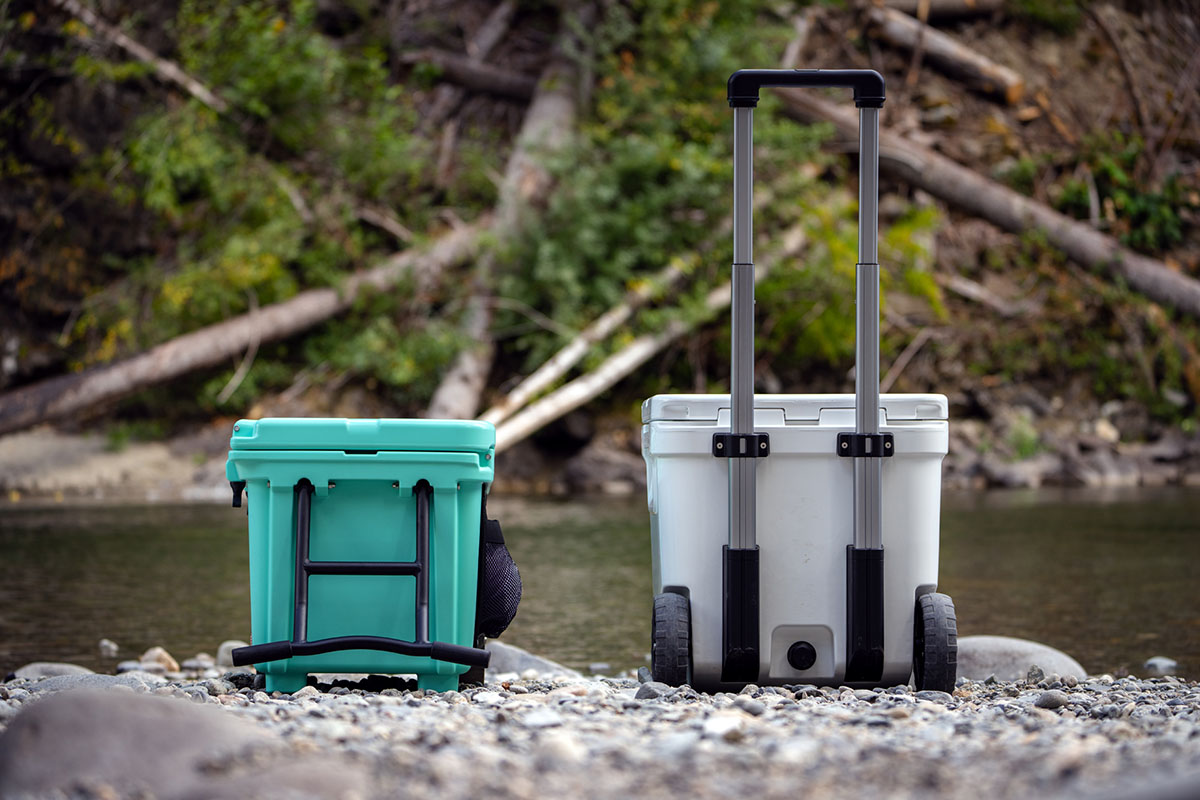
Wheels make coolers considerably easier to transport once they’re on the ground, but most designs are hefty and difficult to lift in and out of a trunk or truck bed. For reference, most hard-sided options above check in around 30 to 35 pounds, with the heaviest on our list being the Pelican 80QT Elite at a whopping 49.5 pounds. Once loaded down with ice, food, and beverages, that number skyrockets. At the other end of the spectrum are soft-sided models like the Coleman Chiller 42-Can (7 lb. 3.2 oz.), which are much easier to pick up and move around when needed but make notable compromises in durability and cold retention. In the middle are plastic options like Coleman 50-Quart Xtreme (12 lb. 11.2 oz.), which are lighter than premium rotomolded competitors and more thermally efficient than soft-sided coolers. In the end, it’s up to you how much weight you think you can manage.
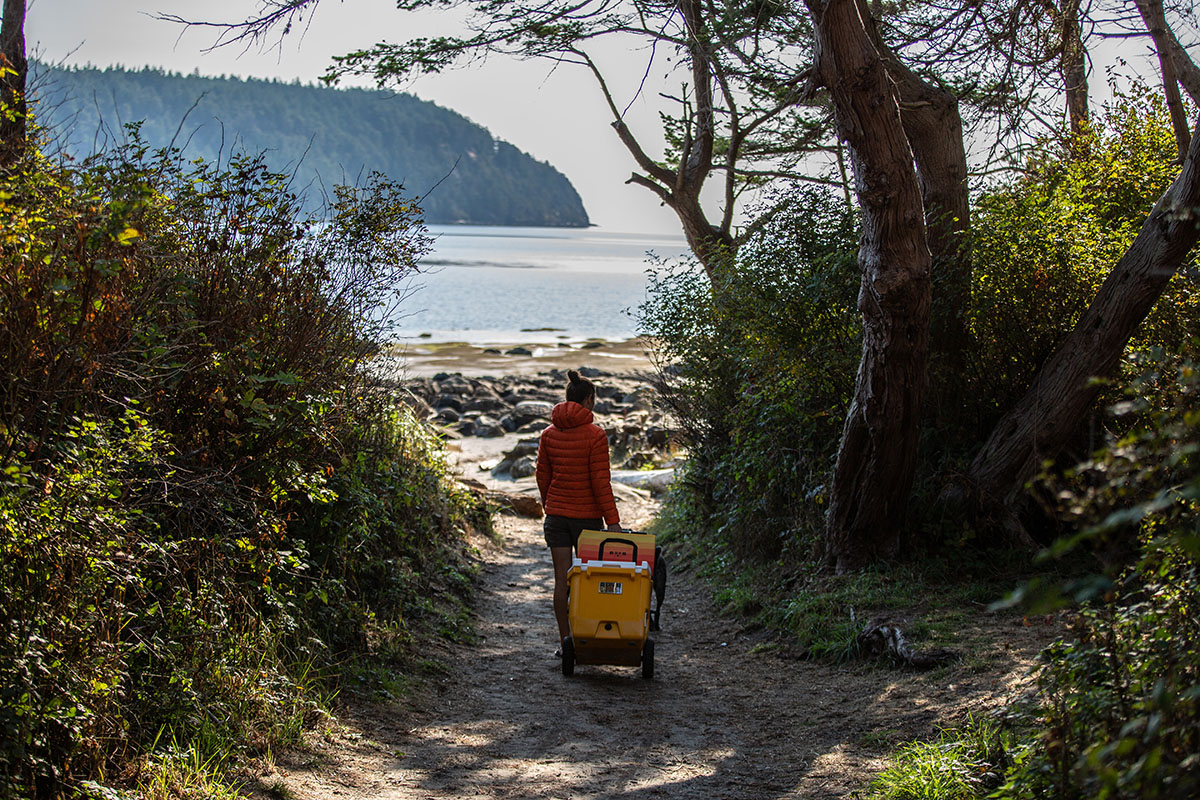
It seems to depend on what you're doing with it. Wheeled coolers from Yeti, RovR, and other higher-priced models are able to keep ice frozen for significantly longer than budget options from companies like Coleman or Igloo. And while bags of ice come relatively cheap, it can be a real pain to have to drain your cooler and replace the ice daily (not to mention having to travel and purchase more). Another benefit of high-end hard-sided units is durability—the difference in quality is immediately apparent, and some of the best out there are truly meant to last a lifetime. All that said, if you just need a reliable cooler for days at the beach or packing a lunch on the road, you probably don't need to spend all that cash.
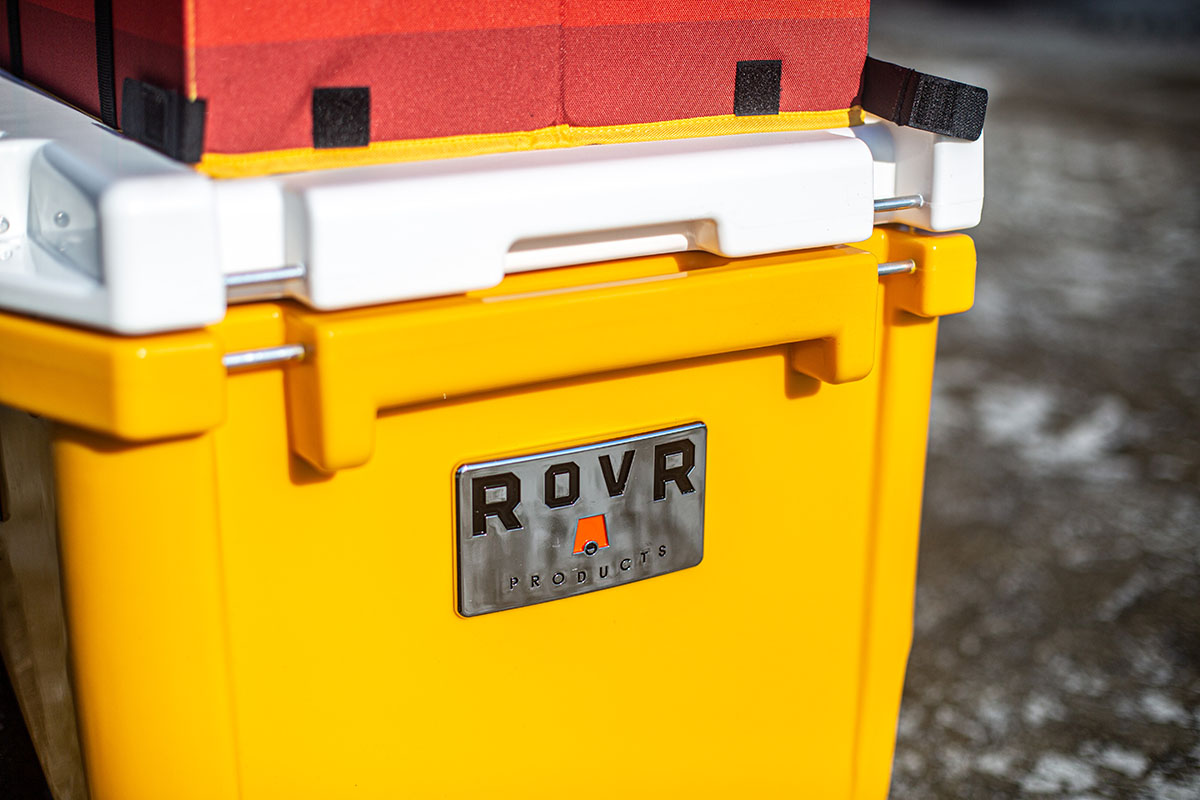
A final factor when considering a high-end cooler is longevity. Simply put, coolers are unlike most other categories of outdoor gear that may last just a couple of seasons before needing to be replaced. We have a family member who purchased an original Yeti Tundra back when the line first hit the market in 2008, and the cooler is basically like new today (he had to replace one rubber latch after more than 10 years of use, but that’s it). This means that when you’re calculating whether spending $400+ on a cooler is worth it, remember that you’re getting a product that literally should last for decades—and many of the high-end brands back their coolers with generous warranties, which we cover below. That said, if you don’t need multi-day ice retention, even a cheaper wheeled cooler should last multiple years.
A cooler’s latch or closure system is one of the defining characteristics of a premium model and plays a significant role in overall cooling performance. Our favorite latch design belongs to Yeti’s Roadie: Dubbed “QuickLatch,” the system is incredibly easy to operate even with one hand and provides a very confidence-inspiring seal. Most high-end competitors instead feature rubber T-handles to keep the lid locked securely in place, which are user-friendly, strong, and minimize any openings for cold air to escape (or warm air to creep in). However, we’ve found some T-handles to be noticeably stiff and difficult to manipulate, including those on the RovR RollR. At the other end of the spectrum, Coleman's Xtreme and Igloo’s Trailmate Journey forgo latches entirely and rely on a good fit between the lid and cooler body. This results in reduced insulating performance and means you’ll need to keep an eye on the lid to make sure it doesn’t pop loose in transport.
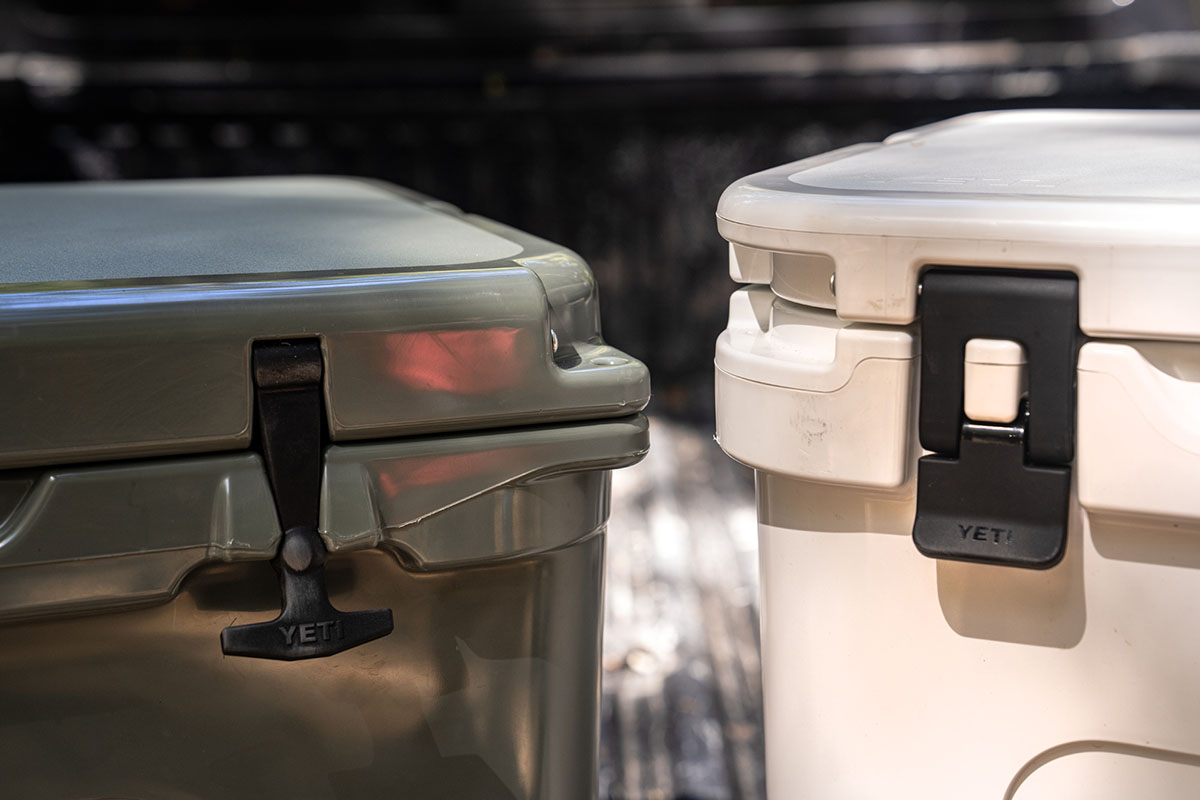
Unlike standard hard-sided coolers, wheeled coolers typically aren’t certified as bear-resistant, which is a worthwhile consideration should you be camping in bear country. One exception above is Pelican’s 80QT Elite, and Yeti’s Tundra Haul also meets IGBC (Interagency Grizzly Bear Committee) standards for bear resistance with the appropriate locks, which are sold separately. If you frequent the backcountry or will be traveling where bear-proof gear is required, make sure your cooler is on their list of approved designs.
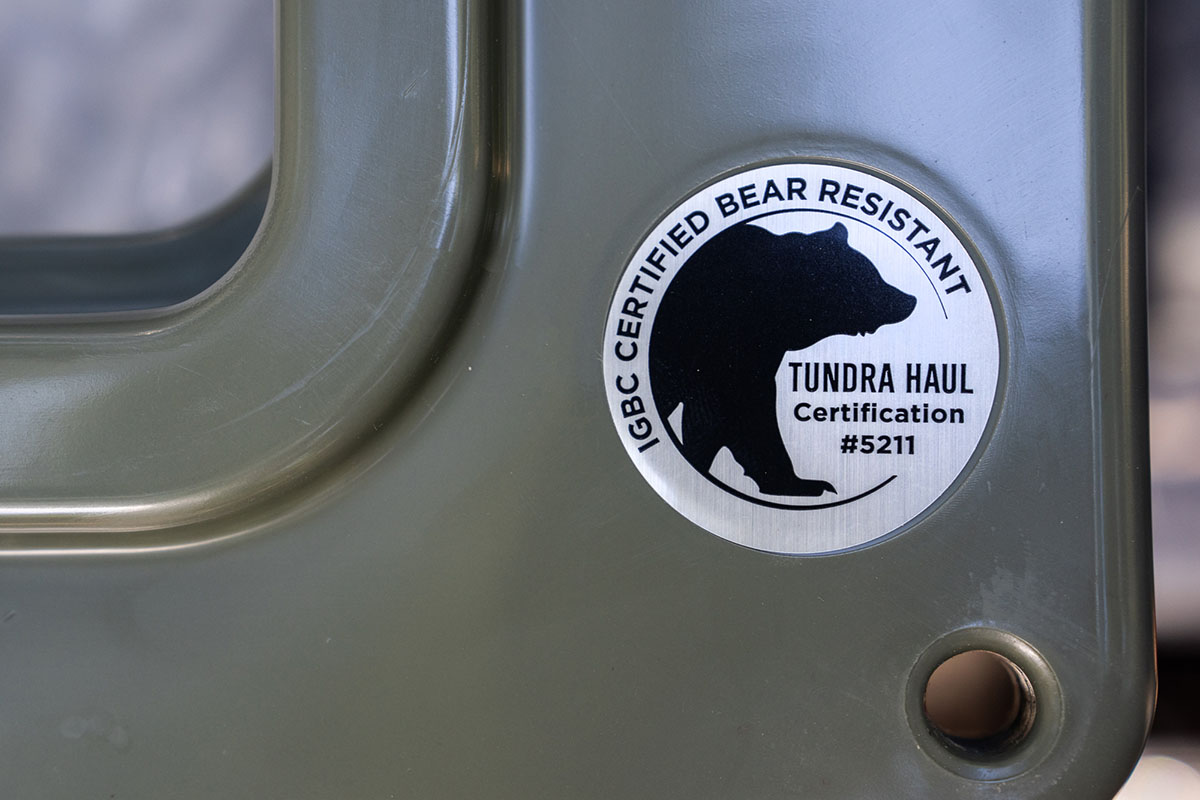
All of the hard-sided wheeled coolers on our list have drainage systems to help you empty out water once your ice has melted. Typically, this comes in the form of a screw-on or pop-off cap at the base of the cooler—simply take it off and let the water pour out. Some also boast drainage channels or slanted interiors that funnel water through the opening (including RovR's RollR), which is a nice touch for helping with the clean-up process. Soft-sided designs like the Coleman Chiller forgo drainage systems and require removing food, drinks, and ice in order to drain any water. However, given these coolers’ smaller capacities and limited ice retention, most users will be restocking the contents frequently anyway.
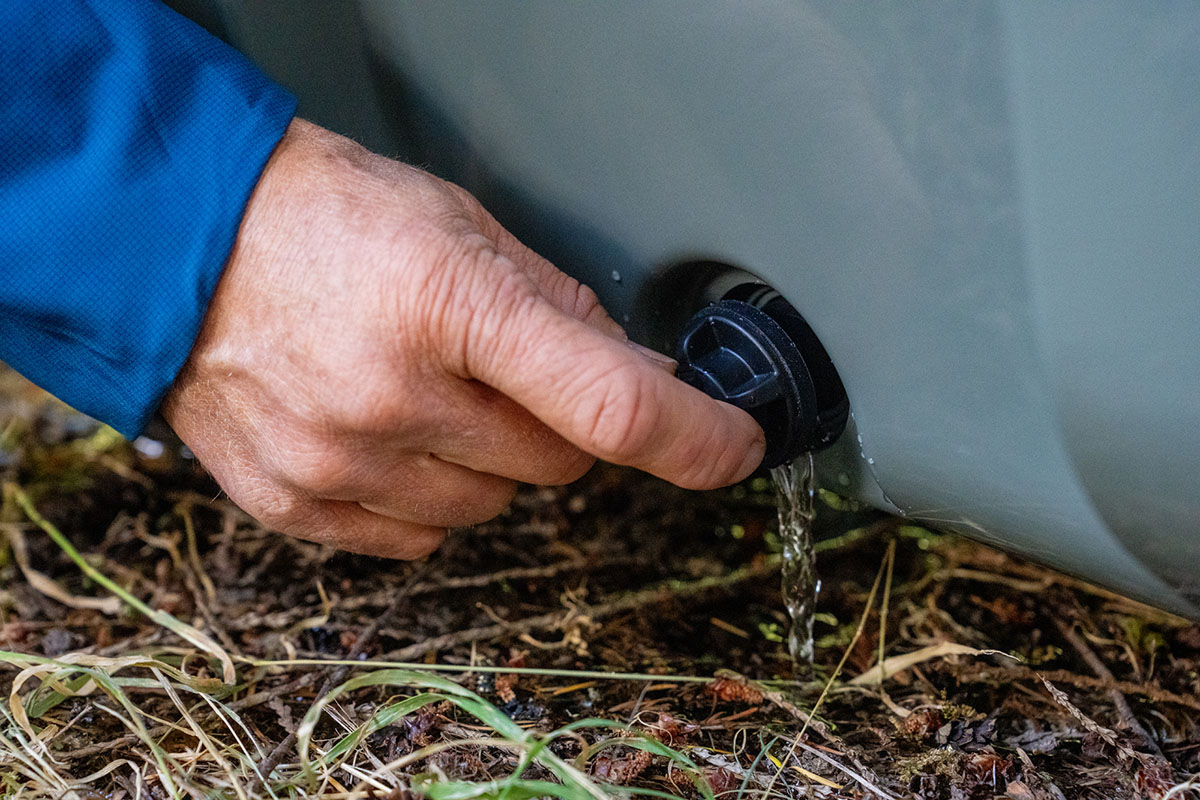
In addition to wheels, handles, and drainage systems, non-slip rubber feet are very common and help keep your cooler in place during transport. They also elevate the cooler slightly off the ground, which can help with ice retention, especially on hot and sunny beach days. Other features to look out for include bottle openers, cup holders, and additional storage in the form of exterior or interior pockets. A standout on our list is the Igloo Trailmate Journey, with multiple storage compartments, slots for a fishing rod or umbrella, and a “butler” tray that stores under the lid when not in use. The soft-sided Coleman Chiller is also rife with storage, including bungee systems to attach an extra layer or accessories.
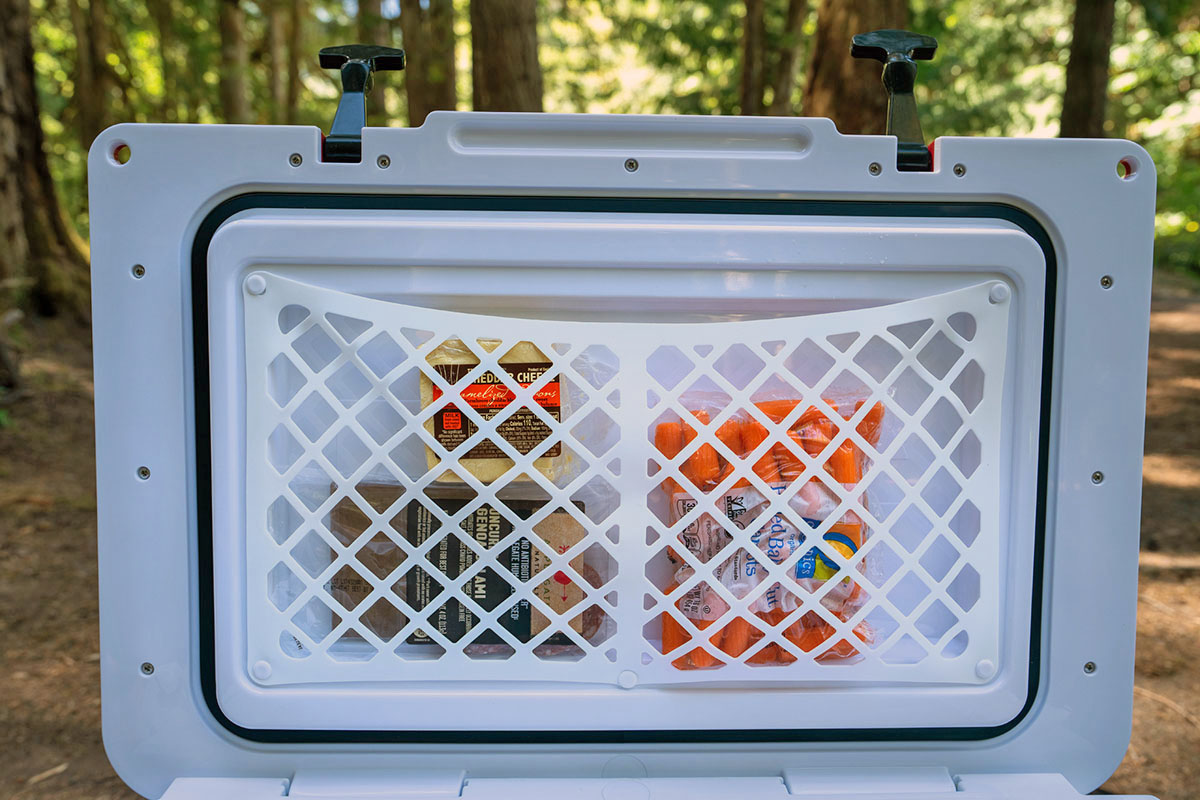
If you’re someone who likes to customize your gear, there are a number of useful add-ons and accessories available for many wheeled coolers. For example, food baskets—which are included with some but not all models—can be a great way to store fruit and other fragile items, dividers are handy for cordoning off various meals, and external attachments like cup holders and side tables can increase storage and prep space. Most well-known brands sell these accessories directly on their website, although they can increase the overall cost. One of our favorite unique add-ons is RovR’s BikR Kit, which allows you to tow the RollR behind your bike. Their LandR Bins are also practical for stashing dry goods, towels, and other necessities for the day and fit on top of the RollR coolers. Finally, many manufacturers sell replacement parts should you encounter any issues with components like gaskets, wheels, drain plugs, or latches.
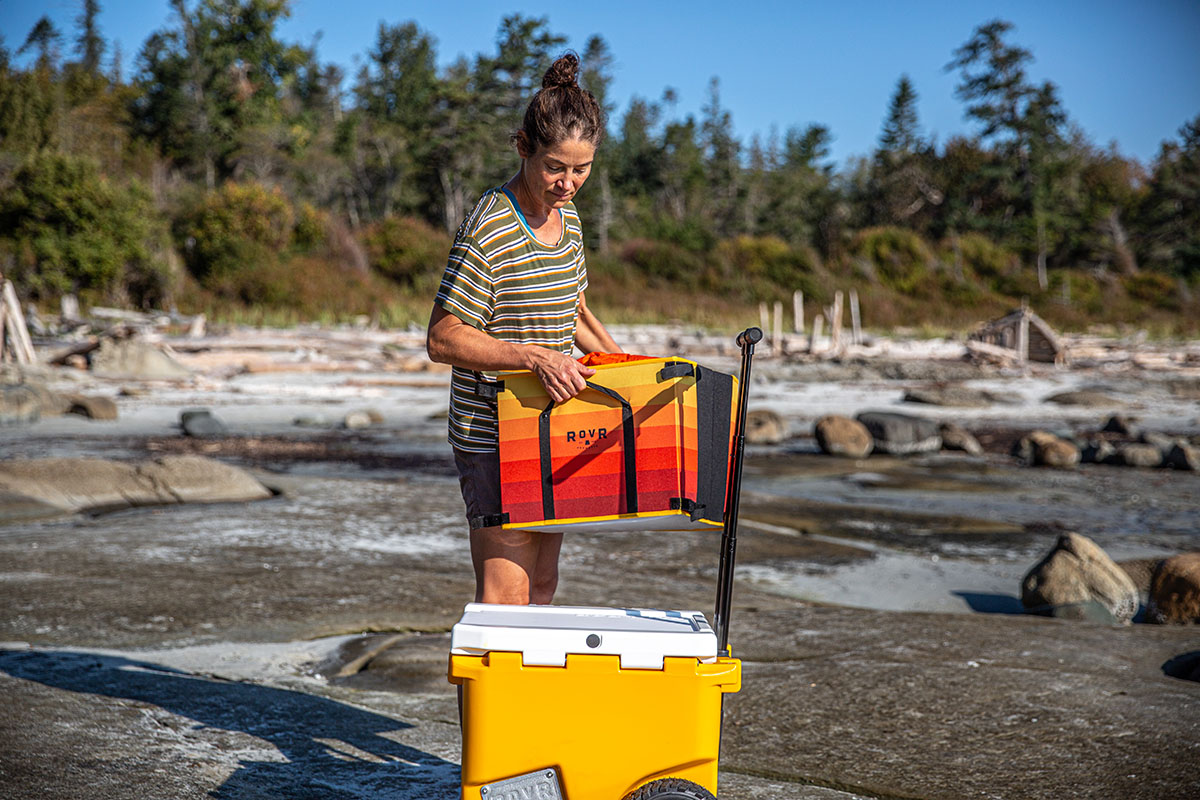
As committed cooler enthusiasts know, the type of ice you use heavily impacts how much you’re able to store and how long it stays frozen. Crushed ice is the most readily available—you can find it at most gas stations and supermarkets for fairly cheap. The major draw is that it easily fills the gaps between your food and beverages, cooling them quickly and efficiently. However, crushed ice is also the fastest to melt, meaning you’ll likely need to replace it often. Blocks of ice take much longer to melt than crushed ice, but they’re bulky and take up a lot of space in the cooler. If we have enough space, our preferred method is to use both block and crushed ice together, and Yeti has more great tips here.
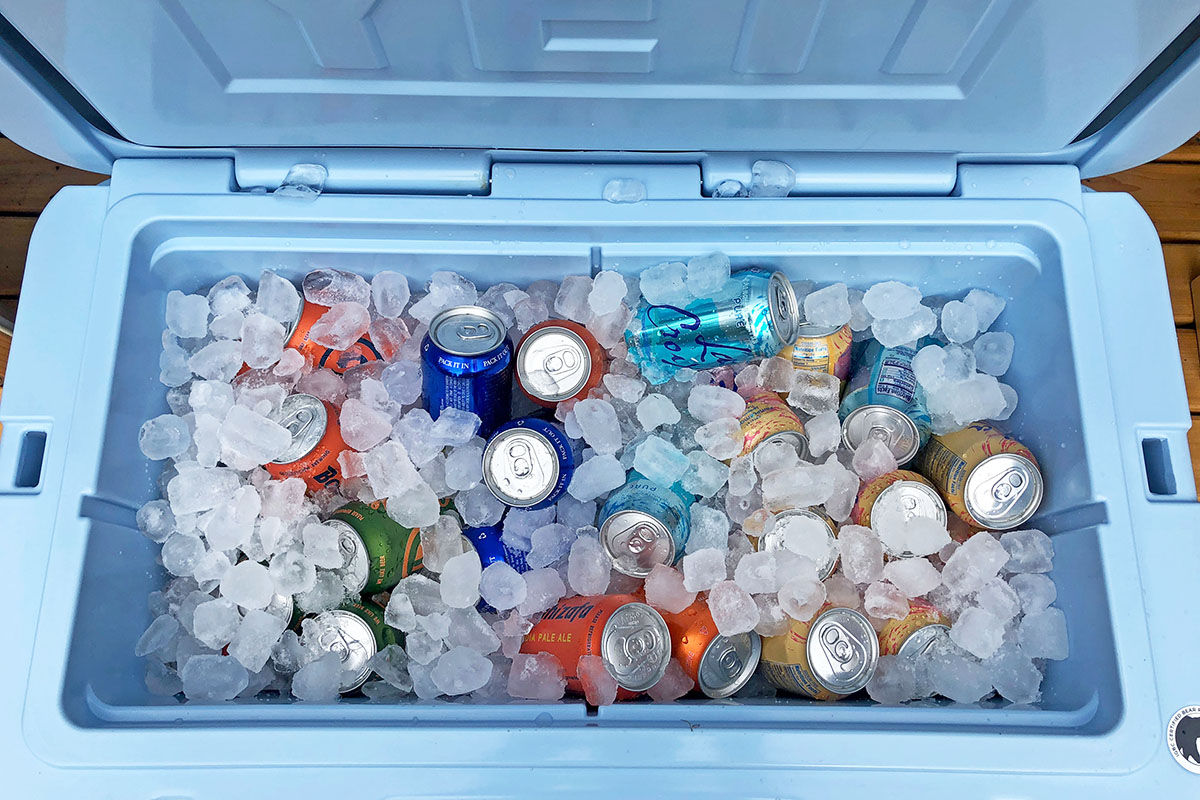
If you’re worried about re-stocking, ice packs are a viable alternative. Most major brands sell their own designs that work well in their coolers, and you can use them repeatedly without ever having to drain melted ice. That said, ice packs are fairly expensive (Yeti's range from $15 to $30 depending on size) and require refreezing once they lose their coldness, which limits practicality for longer trips.
A final option to consider is dry ice. Since dry ice is frozen carbon dioxide, it passes directly from a solid to a gaseous state, meaning no water to deal with as it melts. However, dry ice can be dangerous to touch (you have to wear heavy gloves to prevent frostbite), doesn’t last long, and many coolers aren’t even rated to handle it. All told, it might take some finessing to perfect your strategy, but we think a combination of crushed and block ice is the best (and safest) method.
Coolers are undoubtedly expensive, and wheeled coolers are especially pricey given their large size and added features like wheels and handles. Having a generous warranty can help ease some of the buying anxiety, and the good news is that many wheeled coolers are covered for several years, if not more. Pelican is at the top of the pack, offering a lifetime warranty that covers defects, although they specify that certain components—including the wheels, rubber feet, drain plug, gasket, and accessories—are only covered for 90 days. Most other manufacturers have one- to 10-year warranties, including Yeti’s Roadie and Tundra Haul collections (both five years), RovR’s RollR (five years for the body and one year for all other components), and RTIC’s Ultra-Light (three years).

Given their frequent exposure to food, drinks, and the outdoors, wheeled coolers can get dirty and smelly fast. The upside is that most are easy to clean and maintain. After each trip, it’s good practice to wipe down the interior with soap and warm water. For removing stubborn grime or odors, Yeti recommends applying a 6:1 solution of warm water and bleach with a brush or using a high-pressure sprayer. It’s a similar story with soft-sided models like the Coleman Chiller. The Coleman comes with a removable plastic liner that’s easy to wipe down and leave out to dry, while the Titan has an antimicrobial liner that’s quick to clean.
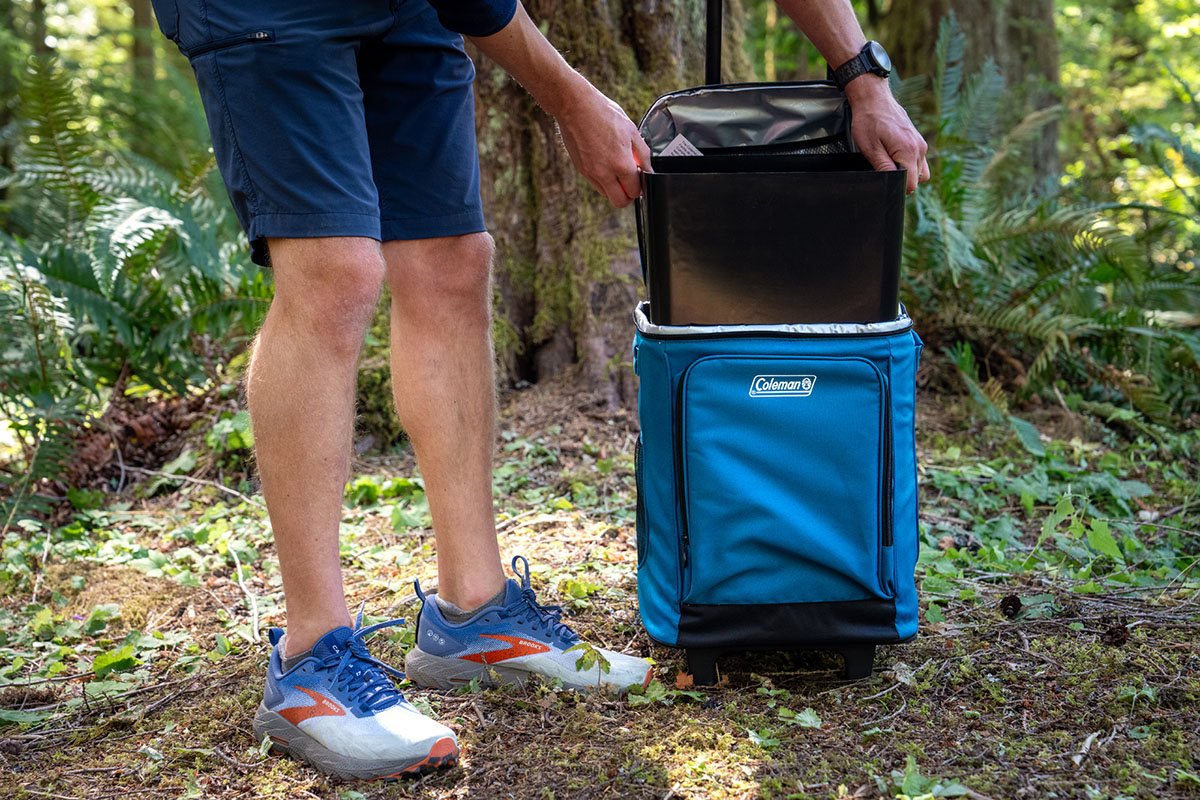
We exclusively cover wheeled coolers above, which are great for those who plan on covering distances. If space is at a premium, you don’t mind carrying your cooler, or it’ll find a semi-permanent home in, say, a raft, a standard hard-sided model will get the job done for less. Yeti’s Tundra 65, for instance, costs $75 less than the 10-quart-smaller Tundra Haul. It’s also worth noting that there are a few companies that sell wheel kits or caddies to turn a standard hard-sided cooler into a wheeled cooler. One example is Camco’s Cooler Cart kit, which includes straps and 12-inch wheels with all the necessary hardware to attach to your cooler. It fits most hard-sided models up to 17.5 inches wide with tie-down slots.
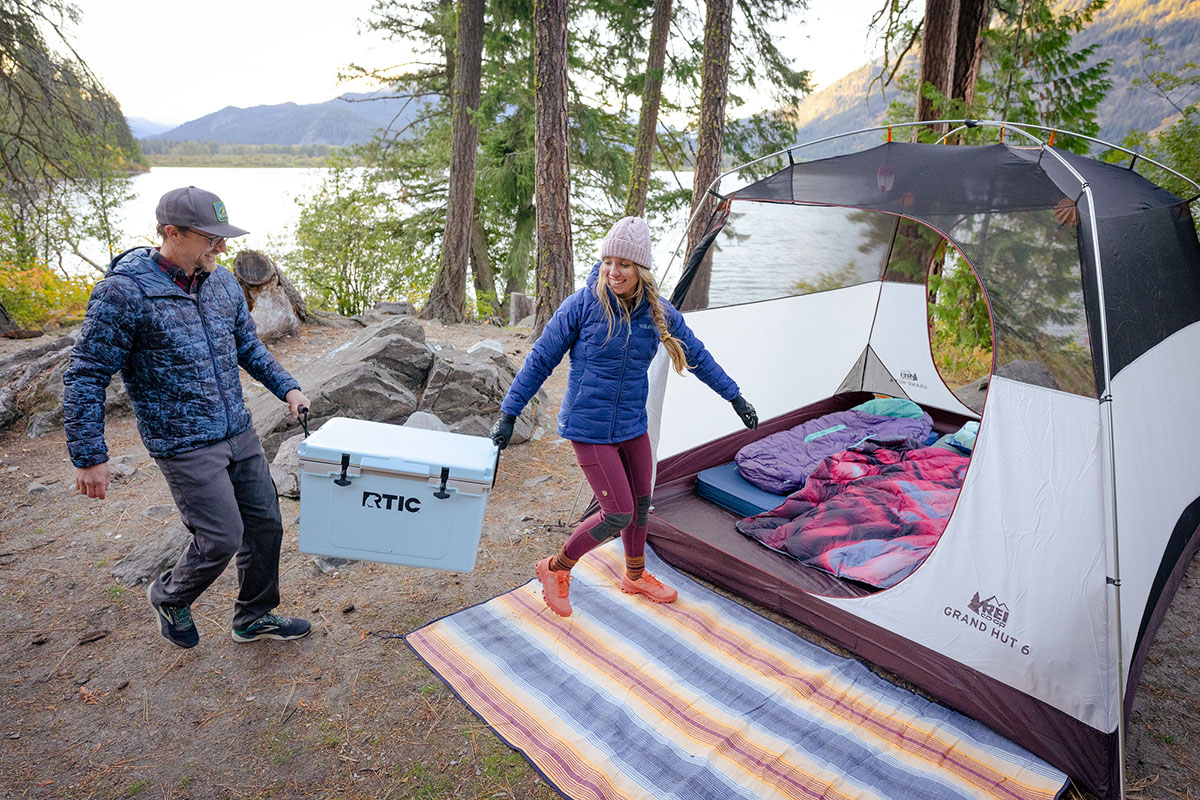
Alternatively, soft coolers don’t offer the same ice retention as hard-sided designs (typically ranging from one to three days) but generally weigh around 5 pounds or less, are more portable and often collapsible, and come much cheaper. They can also be a great supplement to a larger hard-sided model, providing additional space to store extra food or beverages when camping with a larger group. A final alternative is the backpack cooler, which is a purpose-built option for those who want the easy portability of a backpack with the insulating performance of a cooler—great for approaches to a favorite picnic spot or fishing hole. For more information and our top picks in each category, check out our articles on the best coolers, best soft coolers, and best backpack coolers.
Back to Our Top Wheeled Cooler Picks Back to Our Wheeled Cooler Comparison Table